4 Days in Mexico City: Complete Itinerary For First Timers
As soon as we start talking about Mexico City in the guide below, it’s going to become very clear very quickly that we are deeply in love with it.
After three trips over the past several years and a total of almost a month in Mexico City, we finally feel like we’ve scratched the surface of understanding what makes the city special.
It’s a great city for a variety of reasons, from the excellent public transportation that will take you anywhere you need to go (more of that at home in the U.S., please!), to the excellent food and drink scene from street food to top 10 restaurants in the world.
But the thing that stands out to us after our latest trip is the rich cultural and historical context behind those things, which we dove into with a walking tour (this is the tour we did, which we loved) and a tour of the Anthropology Museum, among other things.
That understanding of how Mexico City went from a city on a lake (not on the shores of a lake, ON THE LAKE) to the urban sprawl that it is today gave us a deeper appreciation and understanding of this special place.
It’s a key reason why, in this guide to 4 days in Mexico City, you’re going to find a lot of experiences that put you in a position to connect with locals who will help you see the city through their eyes.
But enough about us, let’s talk about what YOU are going to find in this guide.
In this guide, we’re going to give you a 4 day Mexico City itinerary that is informed by our own experiences exploring the city over three different trips.
We’ll start with some logistics – like where to stay and how to get around – and then get into a specific itinerary with alllllll the details you need to make the most of your trip.
Our intention is to give you all the information you need to put together your own itinerary, and along the way help you discover a few places or experiences that we loved and think you will too.
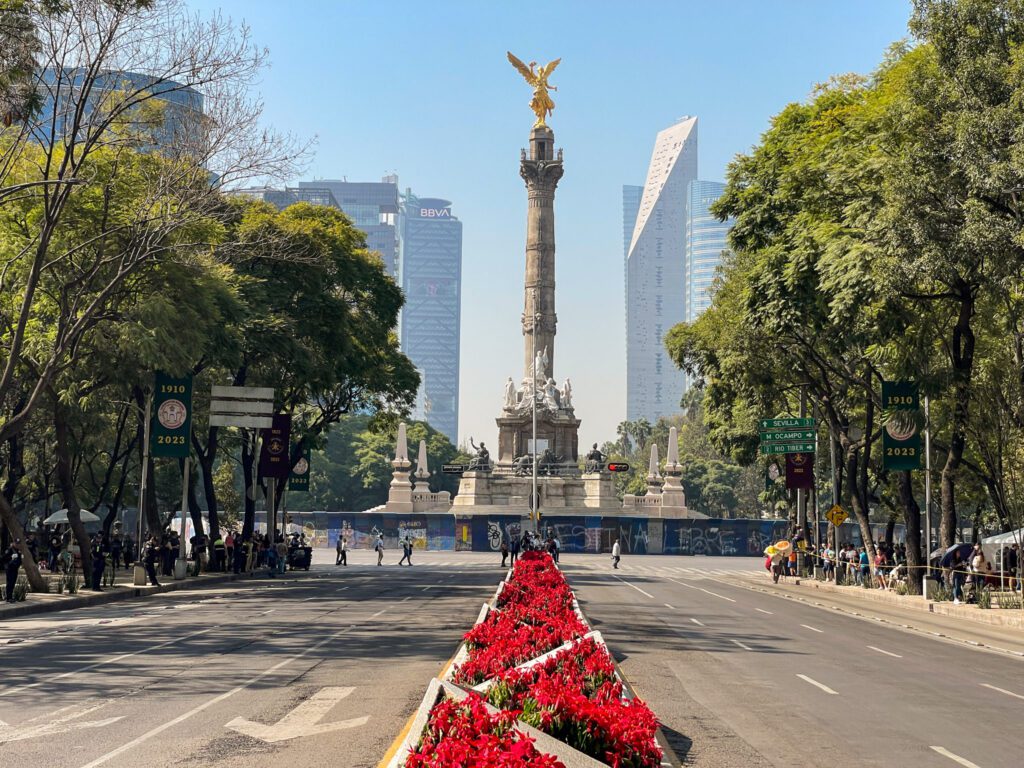
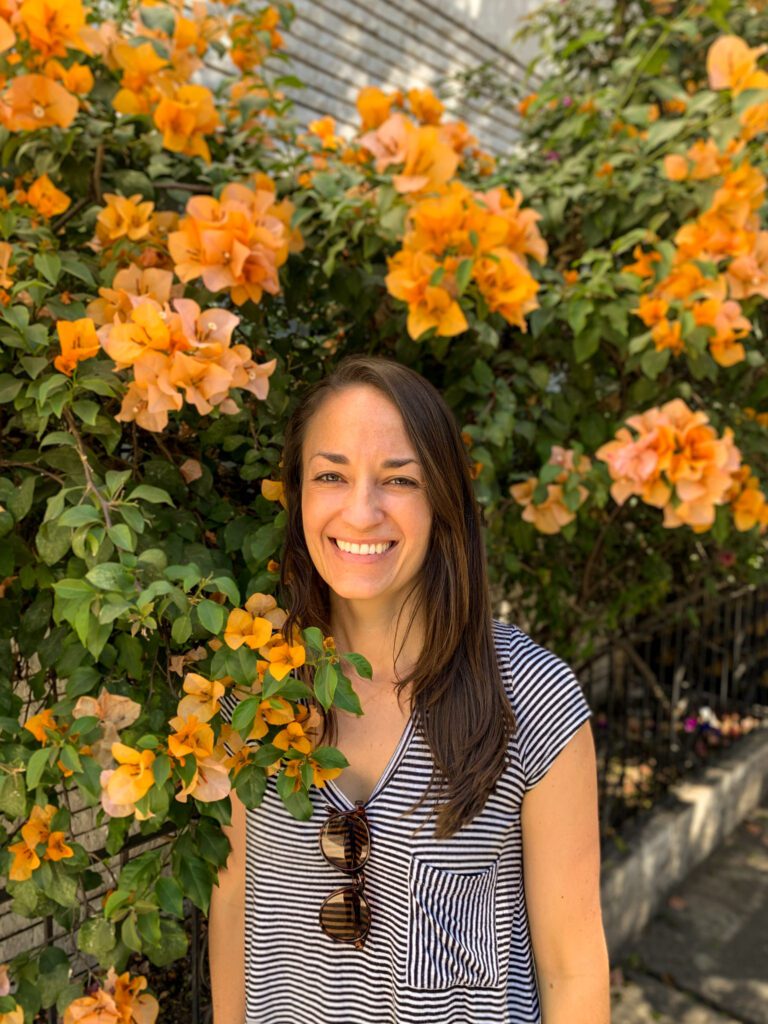
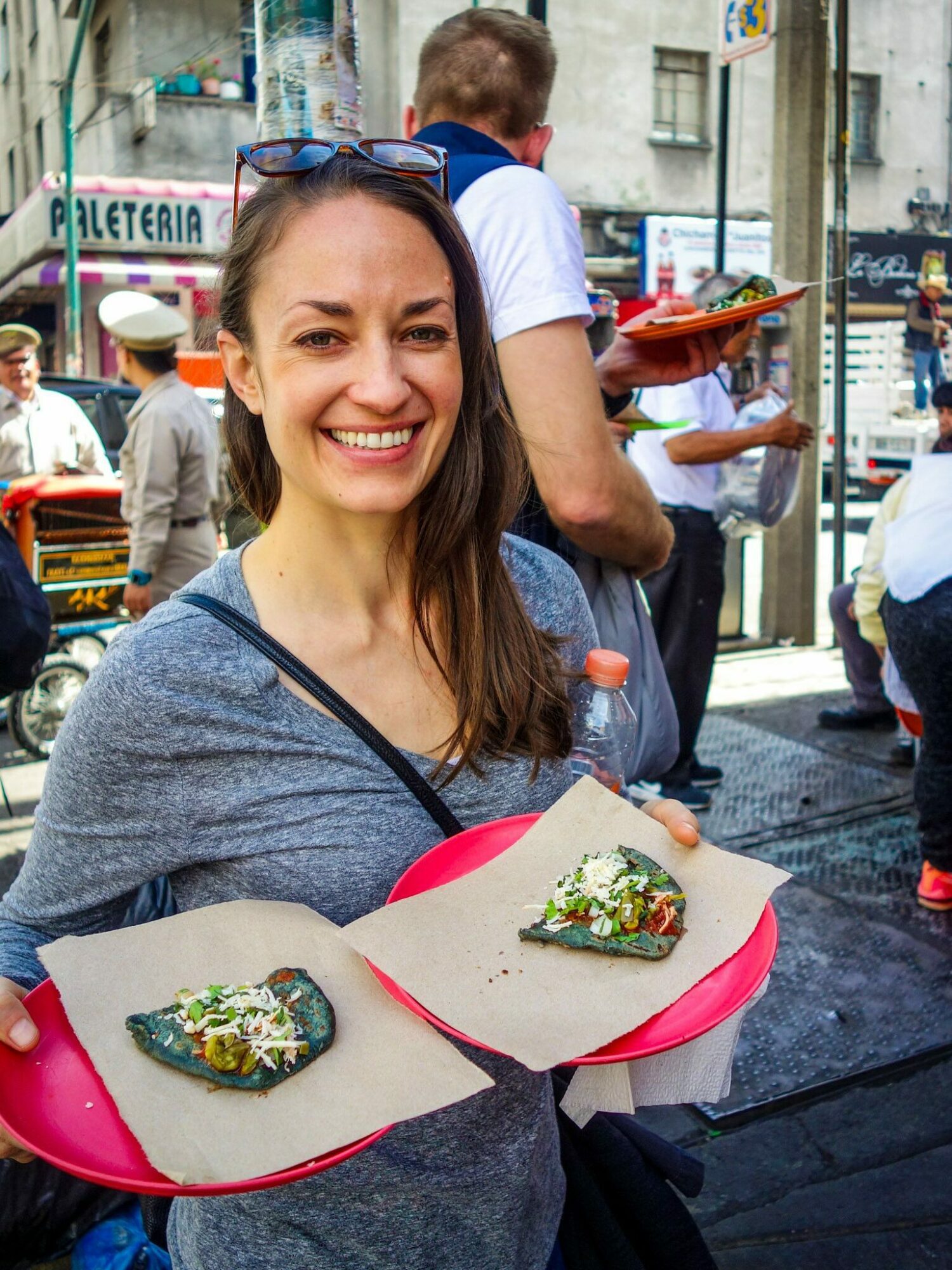
Disclaimer: Some of the links in this post, like hotel links, are affiliate links, meaning at no additional cost to you, we make a little bit of money if you click through and book. That being said, we would never recommend something to you that we don’t stand behind 100%.
How Many Days Do You Need in Mexico City?
The first thing you need to keep in mind as you get into planning your trip is that Mexico City is MASSIVE. By population, it’s the biggest city in North America.
That means that there is a nearly unlimited number of things to do and see around the city, and there is no chance that you’re going to be able to fit every possible thing to do, see, eat, and drink into just four days.
I’ve been to Mexico City three separate times, twice for more than a week, and I still have things on my list that I haven’t quite gotten to.
The intention behind this itinerary is to take our experiences and knowledge about the city to help you figure out what to focus on with your time in Mexico City.
All that being said, we think somewhere between four and six days is a good amount of time to spend on your first trip to Mexico City.
We’ve written this guide below for a four day trip, with ideas for extending your time in the “with more time” section at the end.
Where to Stay in Mexico City
After several trips to Mexico City, including staying in a couple of different neighborhoods (including down in Coyoacán), I would argue that you should stay in the relatively central trio of Roma Norte, Condesa, or Juarez.
Especially if you have a relatively short trip (like four days).
There are a couple of reasons for that recommendation.
The first is the location. These neighborhoods form a nice little triangle on the southeastern side of Chapultepec Park, roughly equidistant between Polanco and the Centro Histórico, which means you’ll never be too far away from wherever you’re going.
Second is the vibes. Roma Norte and Condesa in particular are pretty clearly some of the more affluent neighborhoods in Mexico City. Within them, you’ll find tree-lined streets and some of Mexico City’s best food and drinks.
Those three neighborhoods all offer something slightly different. Here’s a brief summary of each.
- Our top overall recommendation is the charming, tree-lined streets of Roma Norte. Every time we’re in Mexico City we spend the most time in Roma Norte, whether we stay there or not. It’s charming, full of our favorite places to eat and drink in Mexico City, is the starting point for a bunch of fun experiences (like cooking classes and coffee or mezcal tastings), and you can walk to pretty much everything. The downsides are that it’s expensive and, as a result, heavily gentrified and full of tourists and expats. In terms of places to stay, there are a couple of nice guesthouses – Roso Guest House and Ignacia Guest House – that we put on our list for our next trip. If you want an apartment with more space and a kitchen, go with UTOPIC by ULIV.
- La Condesa is a close second, with an equally excellent vibe and two big parks. Pretty much everything we said about Roma Norte applies here, though it’s even more upscale than La Roma (the name means “the countess” if that tells you anything). We heard more English walking the streets of La Condesa than anywhere else in Mexico City. However, between the parks, the tree-lined street that runs around the parks, and the wide array of places to eat and drink from traditional tacos and tortillerias to upscale natural wine bars, it’s a great home base. If you want our top pick, it’s the Red Tree House (they’ve been sold out both times we’ve tried to stay there), which is a fun, affordable guesthouse a few blocks from Parque México. Our favorite hotel here is the gorgeous Casa Decu. If you want an apartment with more space, Be Mate Condesa Hipódromo is your best bet.
- Juárez is a slightly more budget-friendly neighborhood with a similarly great location and selection of places to eat and drink. However, despite the close proximity, it’s not on nearly as many tourist’s radar, which means it’s a little more affordable than Condesa and Roma Norte. It’s more of a concrete jungle, with some of Mexico City’s biggest skyscrapers.
- If you’re traveling with family, we’d choose either Roma Norte, La Condesa, or Coyoacán. The latter is a little further out, which isn’t convenient for short trips, but it’s a former small colonial town that has since been swallowed up by Mexico City’s expanding urban sprawl that offers a completely different vibe and price point.
P.S. We really wouldn’t recommend staying in the Historic Center (the Centro Histórico). It’s loud, busy, and a little overwhelming. Definitely visit, but we probably would stay elsewhere.
For more detail, you should head over and read our guide to the best places to stay in Mexico City, which has our four favorite neighborhoods, pros and cons for each, and a selection of hotels and guesthouses that stand out to us as particularly fun or interesting.
Getting Around Mexico City
Remember that Mexico City is the biggest city in North America. In terms of getting around, this has two major implications.
First, traffic is a nightmare. Essentially every day between 11am and 7pm, the main arteries for getting around the city are bumper to bumper.
It can take a long time to get between neighborhoods at those peak times (e.g. between Centro and Roma Norte, or Condesa and Coyoacán).
That means that you’re either going to need to build in extra time to get from place to place if you have a solid time commitment (like a tour), or you’re going to want to lean on public transportation, which generally avoids traffic thanks to the underground subway and dedicated bus lanes.
Second, you’re just not going to be able to walk between neighborhoods as much as we’d personally like. We’re big walkers, and we’d say that, generally, it’s best to walk within a neighborhood.
However, if you’re trying to get between neighborhoods, the best way to do it is going to be Uber or public transportation.
There are pros and cons for each method, and it largely depends on what you value. Let’s talk about them!
Using Public Transportation in Mexico City
Mexico City’s public transit network is really good in terms of coverage. Between buses and the metro, you can essentially get anywhere you need to go, and it will only cost you 5-8 pesos.
However, that absolutely does not mean it’s the fastest or most efficient way to get around the city.
In fact, almost every time I’ve used public transportation in Mexico City, it has required either a transfer, which can be confusing (especially when the stations are not actually right next to each other) and/or time consuming, or it required a long walk from the stop to my destination.
Plus, it has always been packed to the gills, both on the metro and on the bus. Which isn’t necessarily a pleasant experience.
The advantage to riding public transportation is that you generally skip the debilitating traffic that crawls through the city during rush hour (which seems to be 11am to 7pm or so).
However, that’s also the busiest time on the metro and buses, so it will be crowded.
If you have a set appointment (like a tour or class) during rush hour, I’d lean towards public transportation to avoid being trapped in bumper-to-bumper traffic.
Using Uber in Mexico City
In terms of efficiency (putting traffic aside) and safety, Uber is the best way to get around Mexico City outside of public transit.
Taxis are plentiful and affordable, but communication can be a challenge if you don’t speak Spanish well and the fact that there is no pre-set price means that you can be taken for a ride in terms of cost.
Uber, where you set an origin and destination and agree on a price beforehand, is much more reliable in our experience. We use Uber anytime we can’t walk or public transportation doesn’t get us where we need to go in a timely fashion.
Is Mexico City Safe?
She probably wouldn’t appreciate me saying it, but every time we go to Mexico City, my (Matt here!) mother gets very anxious about safety.
“Stay in touch! Stay together! Be aware of your surroundings!”
Which, to be clear, is generally good advice when traveling just about anywhere.
But that advice never seems to come when we’re visiting, say, Paris or Amsterdam despite those cities being at the same level of risk as Mexico City according to the US State Department at the time of writing.
Here’s what our experiences in Mexico City tell us: In the places that you’re likely to be spending time on this itinerary, we have never felt more unsafe or uncomfortable than we have in cities at home in the United States.
Generally speaking, the tourist-friendly areas of Mexico City which, remember, is a MASSIVE city, are not the parts of the city that are relatively unsafe.
Now, does that mean that there aren’t things to think about when it comes to staying safe in Mexico City. Here are a few that come to mind:
- Leave valuables at home.
- Keep an eye on your belongings in crowded areas and on the metro and buses.
- Avoid walking around alone late at night.
- Choose Uber over taxis (we already sort of covered this above).
Things to Know Before You Go
Here are a few other things to know before you arrive in Mexico City.
Remember that you’ll be at elevation. The city is at 7,350 feet above sea level. The elevation is no joke. Make sure to take it easy for the first day, drink plenty of water, and wear sunscreen.
The sun is intense. This is at least partially related to the elevation (you’re likely a few thousand feet closer to the sun than you’re used to, after all!), but the sun in Mexico City is particularly intense. Sun protection – sunscreen, hats, and long sleeves – are important.
Bring layers, because the temperature swings are wild. We’ve been in Mexico City in the winter months (November, December, and February) and the temperature swing throughout the day means it can be cold in the morning, and jump 30 degrees fahrenheit to be very warm in the afternoon.
Bring chapstick. The altitude makes it so that Mexico City is VERY dry. Chapstick is a must.
Don’t drink the tap water. Unfortunately, the tap water in Mexico City is not safe to drink. Your best bet is, sadly, bottled water. We’d recommend bringing a reusable water bottle and buying big jugs of water (five or ten liters) to refill, rather than buying a bunch of small plastic bottles.
Many people speak English, but some level of Spanish is very useful (and appreciated). In Mexico City, English is more common than in other parts of Mexico (i.e. Guanajuato) or other parts of Latin America (i.e. Colombia). This is particularly true in Condesa and Roma Norte, where I’m fairly certain I have heard more English than Spanish. However, a little Spanish goes a long way. Learning basic phrases like hello, please, thank you, and “do you speak English” will be very useful, and appreciated by Chilangos.
Rainy season is no joke. Like many places close to the equator, rainy season is a thing in Mexico City, and it happens from about June through October (aka summer). During that time, the sky opens up around 3pm every afternoon and dumps rain for a few hours (or minutes, depending on the day). We like visiting Mexico City in the dry season (aka winter for Americans and Europeans) when the sun provides a lovely break from the neverending gray (at least here in the Pacific Northwest).
4 Days in Mexico City: A Perfect Itinerary for First Timers
And now, let’s get into the meat of this itinerary.
We have a secret for you. And it’s a lesson that it took us years of traveling to finally learn on our three month European extravaganza a few years ago.
Travel is better – and by better, we mean more rewarding, interesting, and fun – when you try your best to connect with locals to see the place through their eyes.
We took that to heart in Mexico City, and have done a bunch of different tours and experiences over the past few visits that have opened our eyes to a new side of the city, culture, and people.
Our biggest tip for Mexico City is to prioritize tours (which is what you’re going to see in this itinerary).
In terms of structure, we always do our best to anchor the days in our itineraries around a main experience, with time on either side for things like coffee, cocktails, and good old fashioned wandering around a neighborhood.
Day 1: Introduction and the Centro Histórico
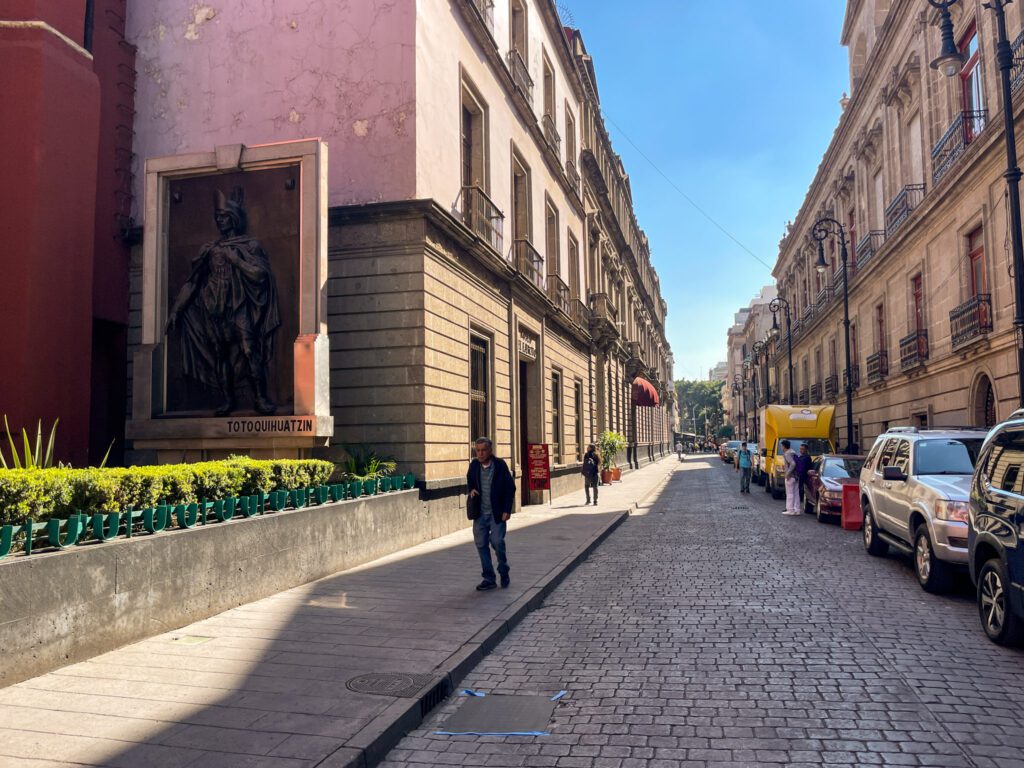
On your first day in Mexico City, it makes the most sense to start with the historic center.
This area is where the city of Tenochtitlan was founded by the Aztecs, who we learned came from the north and decided on the valley where Mexico City sits as their permanent home after hundreds of years of migration led them here.
If you didn’t already know this, Mexico City is essentially built on top of a lake (or swamp depending on who you ask). Hundreds of years ago, it was a series of canals that looked more like Amsterdam than the sprawling metropolis you see today.
Over the past 100 years or so, the vast majority of those canals have been filled in. However, the canals still exist south of the city in Xochimilco, which we think is an important piece of learning about Mexico City (and we’ve included it on day 4 below).
There is one MAJOR problem with that city plan; as they’ve pumped out all the water below the city, the city is sinking.
Especially the denser areas of the city like the historic center, Roma, and La Condesa, which are heavier thanks to the big buildings and number of residents.
Before we go any further on this topic, we want to play a game with you.
How many inches per year on average do you think the historic center of Mexico City is sinking?
We played this game with friends and family when we got home, and the answers we got were somewhere between a half inch and a bold five inches.
Turns out, it’s 20 inches. That’s almost TWO FEET. Which is wild when you think about it.
At some point in the near future, Mexico City will begin to collapse. It’s really just a question of when (most people believe it’s somewhere around 25-50 years away).
But the historic center as it exists today is well worth your time and energy.
We’ve spent basically three days in the historic center at this point, and our favorite way to see it – by far – is to start with a guided tour and then add on some other spots afterwards. Which is exactly how we’ve organized this day of the itinerary.
A Guided Walking Tour of the Centro Histórico
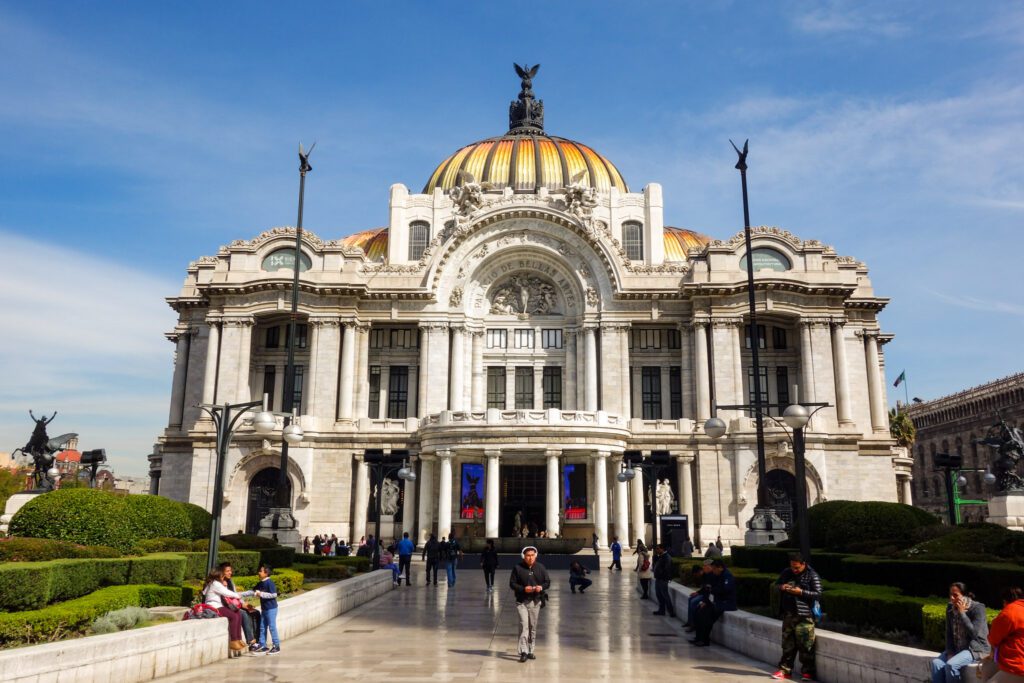
Over the past few years, we’ve come to the realization that walking tours are often our favorite way to get oriented in a new city for a few reasons.
First, you get a crash course in history and culture, which is a valuable baseline that will make the rest of your trip more enjoyable.
Second, you get to spend a few hours with a local who will give you all sorts of tips about what to eat, drink (and see), and specifically where to find the best version of said things.
Last, but not least – and this was especially evident in Mexico City because I had done a self-guided version of this tour and didn’t see 90% of it – you’ll discover places that you definitely would never have found on your own.
For example, in the building covered in Azulejos in the Centro Histórico, there’s a room upstairs with photographs of Mexican Independence fighters including Pancho Villa sitting at the bar in that same building, which was cool.
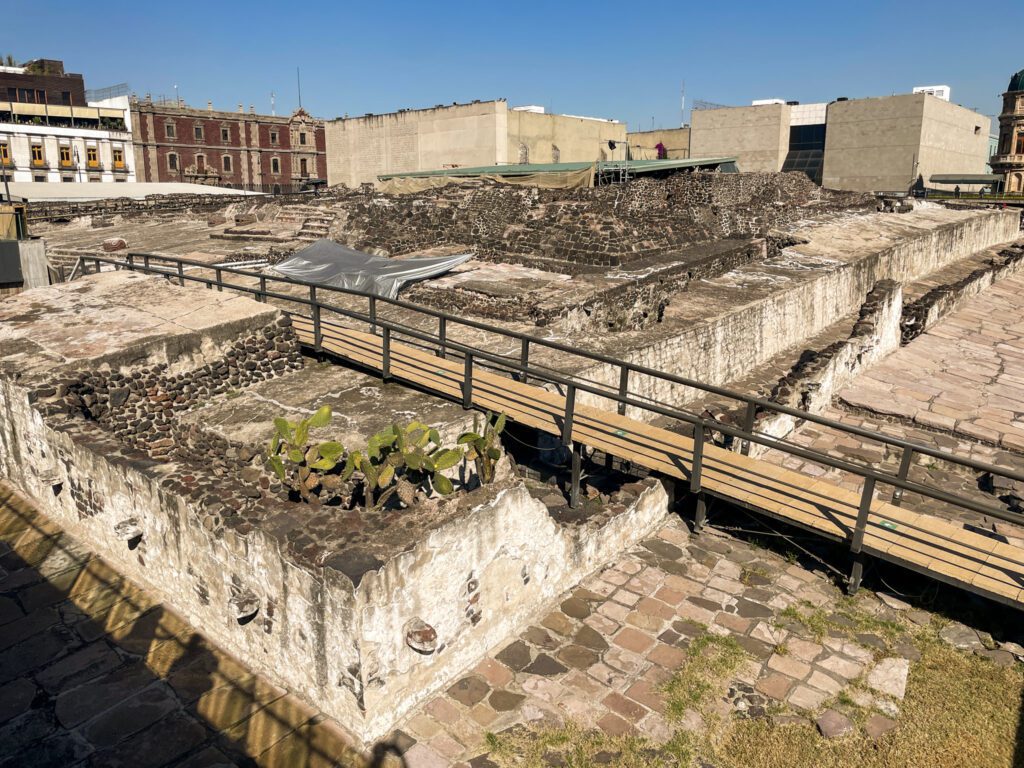
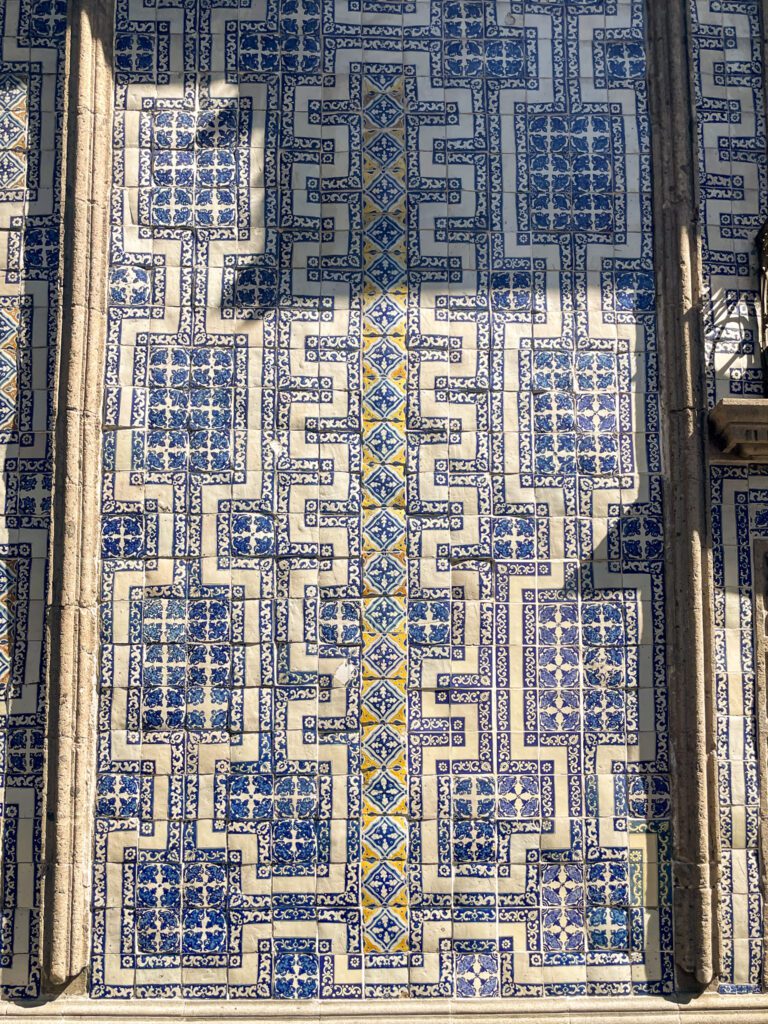
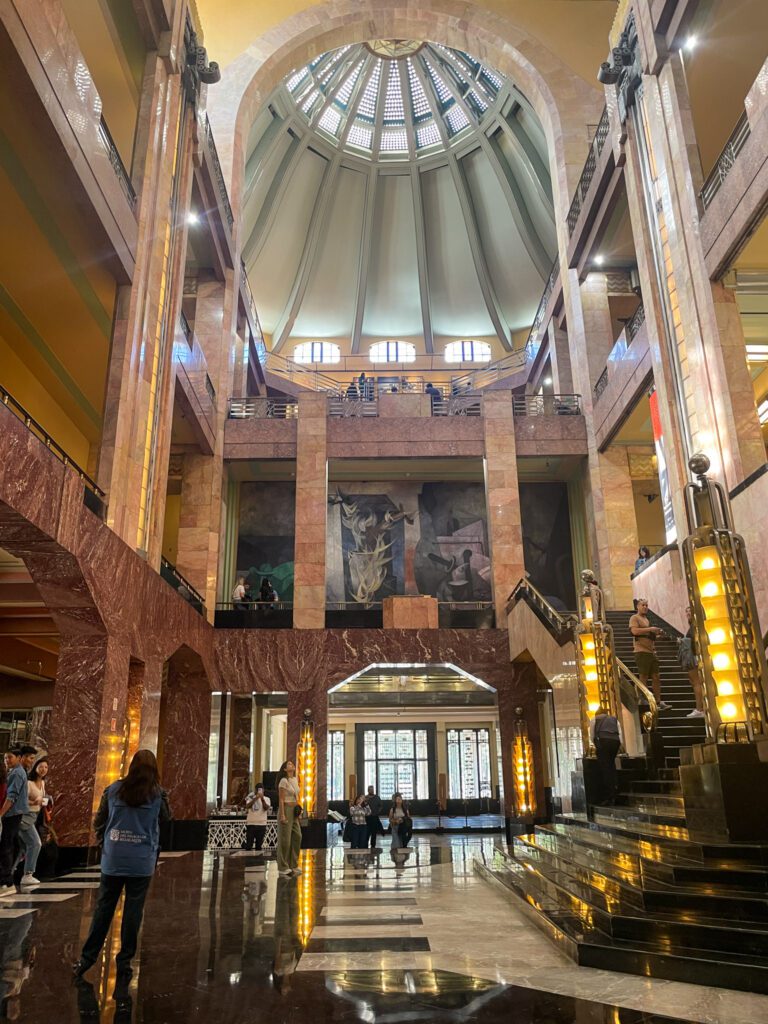
And there is almost no chance we would’ve found that on our own.
All this is to say that if you want to get below the surface of the historic center of Mexico City, which is where the original Aztec/Mexicas city of Tenochtitlan was built on top of a lake, you should absolutely do a guided walking tour.
And, based on our experience with Mariel, an anthropology student in Mexico City who was born there, we think you should spend a few hours with her.
We decided on this private tour because of our group size and my love for With Locals, who connects you with local guides who lead tours around the world.
The tour covers the main sights in the center, including (but not limited to) the Palacio de Bellas Artes, the Zocalo, and the Metropolitan Cathedral.
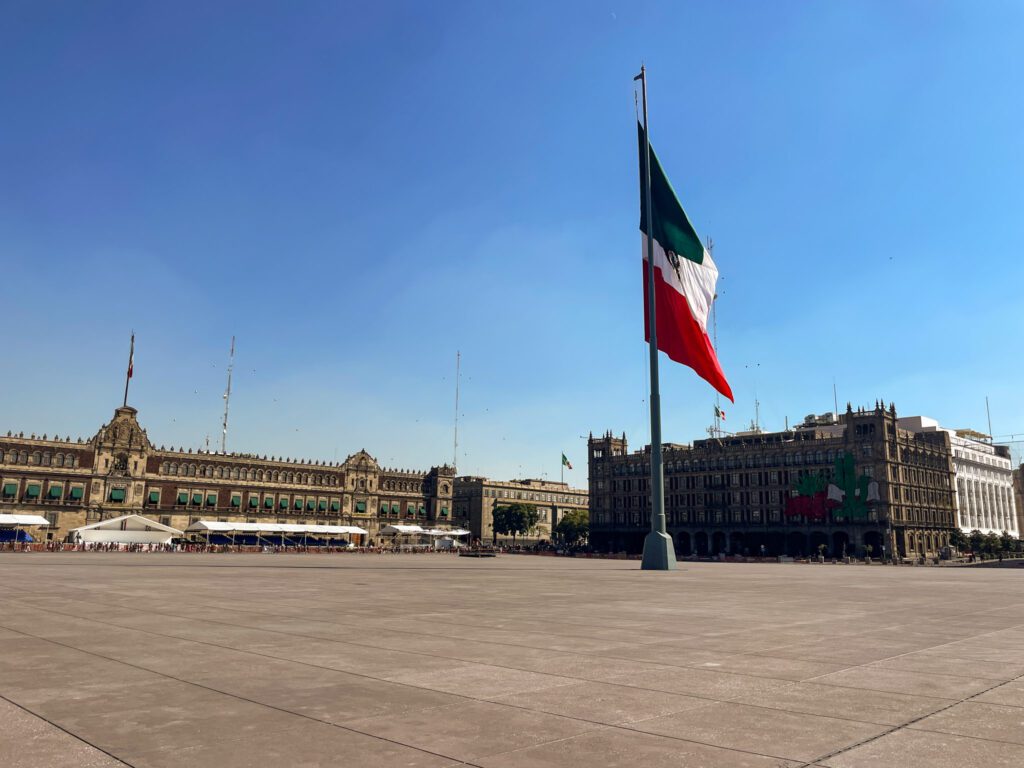
It also covers a few lesser known spots, including a couple of palaces, the most ornate post office we’ve ever seen, and the exterior of Templo Mayor, the Aztec temple that formed the backbone of the ancient city.
The best part, in our opinion, is that you get to choose which local you want to lead your tour, and we chose Mariel because of her upbeat energy, the fact that she is a true local, and the fact that she has a background in anthropology.
All of us agreed that it was a highlight of our trip.
Click here to see prices and availability for the same walking tour we did (and make sure to choose Mariel!).
Tacos al Pastor and Pulque
After your tour, you’re probably going to be hungry. Lucky for you, there are a few fantastic taco spots within a few blocks that are well worth your time.
We discovered these on a street food tour that we did on our first trip to Mexico City many years ago, and revisited them on this latest trip.
El Huequito was tied for our favorite tacos al pastor that we had in Mexico City, and it’s worth noting that the location in the Centro was significantly better than a different location that we visited.
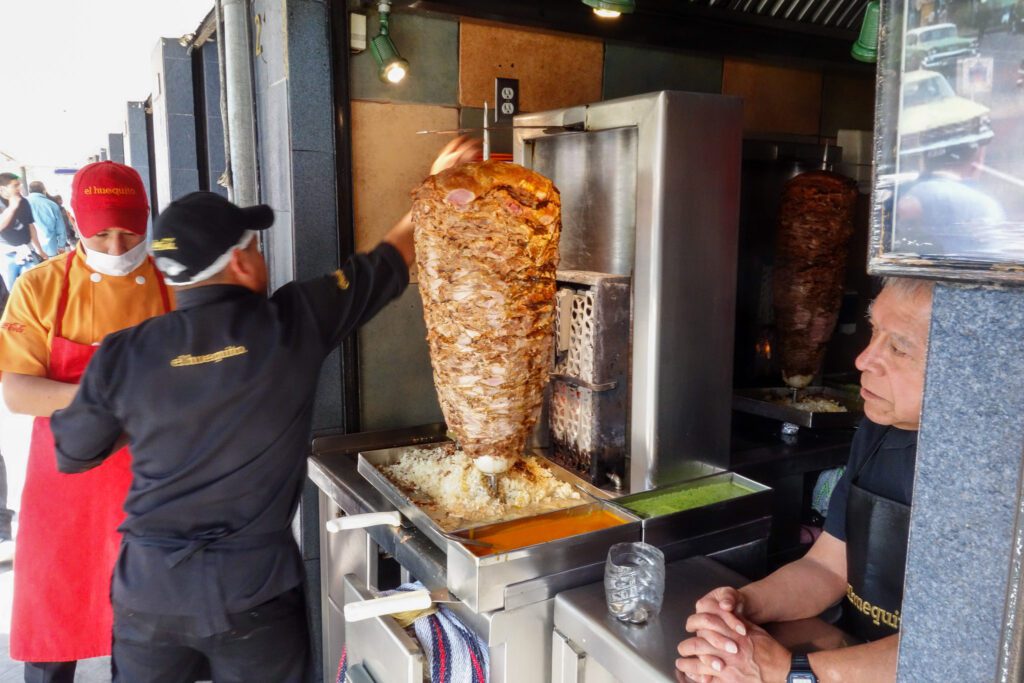
Our favorite way to enjoy tacos al pastor is not to wait in line to sit down inside, but to eat them at the counter.
We watched people just walk up to the taquero (the person handling the meat) and tell them how many tacos they wanted, and what they wanted on them (“con todo” is what you want, which means onions and cilantro).
Then you head to the counter, where you’ll find a range of salsas along with lime slices, which you should apply liberally to all of the tacos. We’re talking a full slice’s juice per taco.
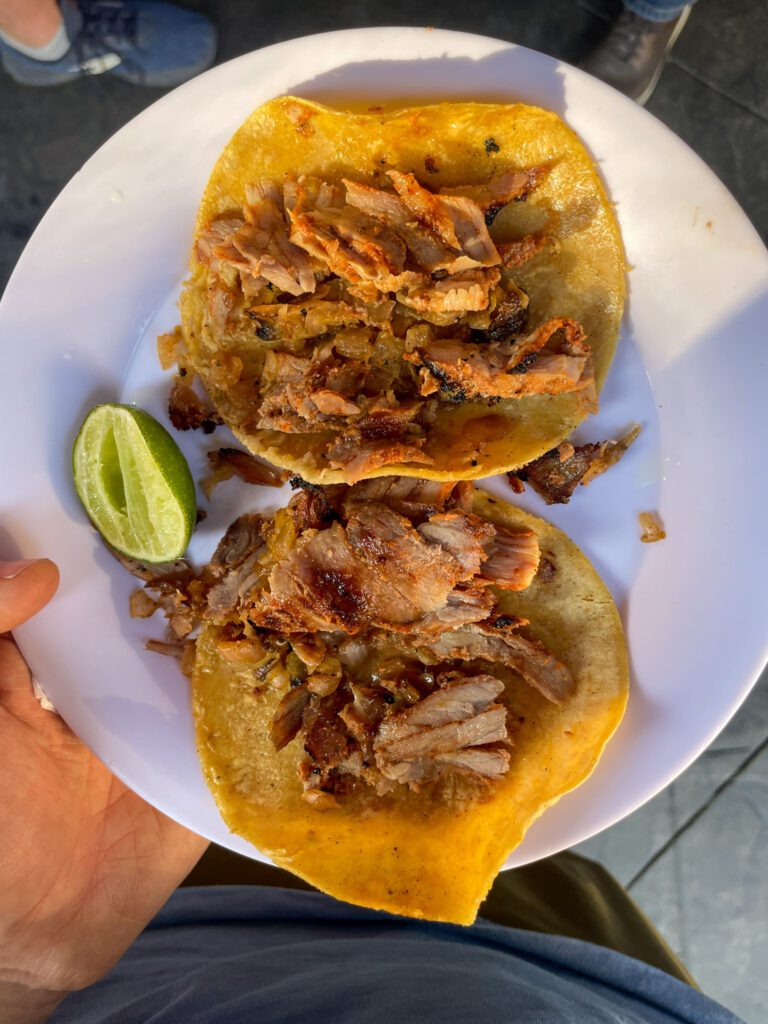
After tacos, it’s time for what was both one of our highlights and also one of the more stressful experiences on our trip.
After devouring tacos, I was looking at Google Maps, and noticed a pulqueria right across the street from El Huequito that had tons of reviews.
My brothers had expressed interest in pulque at various points on our trip, and we decided this was the moment!
Taking a step back, what exactly is pulque?
Pulque is basically fermented agave juice that is back-sweetened (meaning flavoring is added after fermentation) often with fruit juice.
It’s kind of like kombucha in that it’s only 1-4% alcohol, but it’s thick and viscous (kind of like nopales – cactus – when you cut it up).
If you want to read more about pulque, I enjoyed this Serious Eats piece.
That pulqueria we walked into, it turns out, is perhaps the most famous pulqueria in all of Mexico – Las Duelistas (which gets a shout out in that Serious Eats piece).
And pulque is very much an after-work-with-friends kind of thing, and we showed up at around 5pm to an absolutely PACKED house.
So packed that we had to squeeze into a shared table and I didn’t actually take any pictures because I was so worried about either elbowing my neighbor or elbowing my drink.
The one thing that I was surprised by is the age range of the crowd that packed every stool, chair, and crevice.
It was everything from young couples whispering sweet nothings into each other’s ears (presumably because you couldn’t hear each other otherwise) to older men sitting in a circle belting out the ballad playing on the jukebox at the top of their lungs.
I managed to focus enough on one of the server’s lips to understand what he was asking, and we got three glasses of pulque. Two guava – which is my favorite flavor – and one he recommended, cucumber and lime with a Tajín (or something similar) rim.
The guava still wins for me, but they have a rotating selection of five or six flavors. My recommendation is to try the guava, and then ask the server “cual es tu favorito” and get their recommendation, then try that.
Torre Latinoamericana
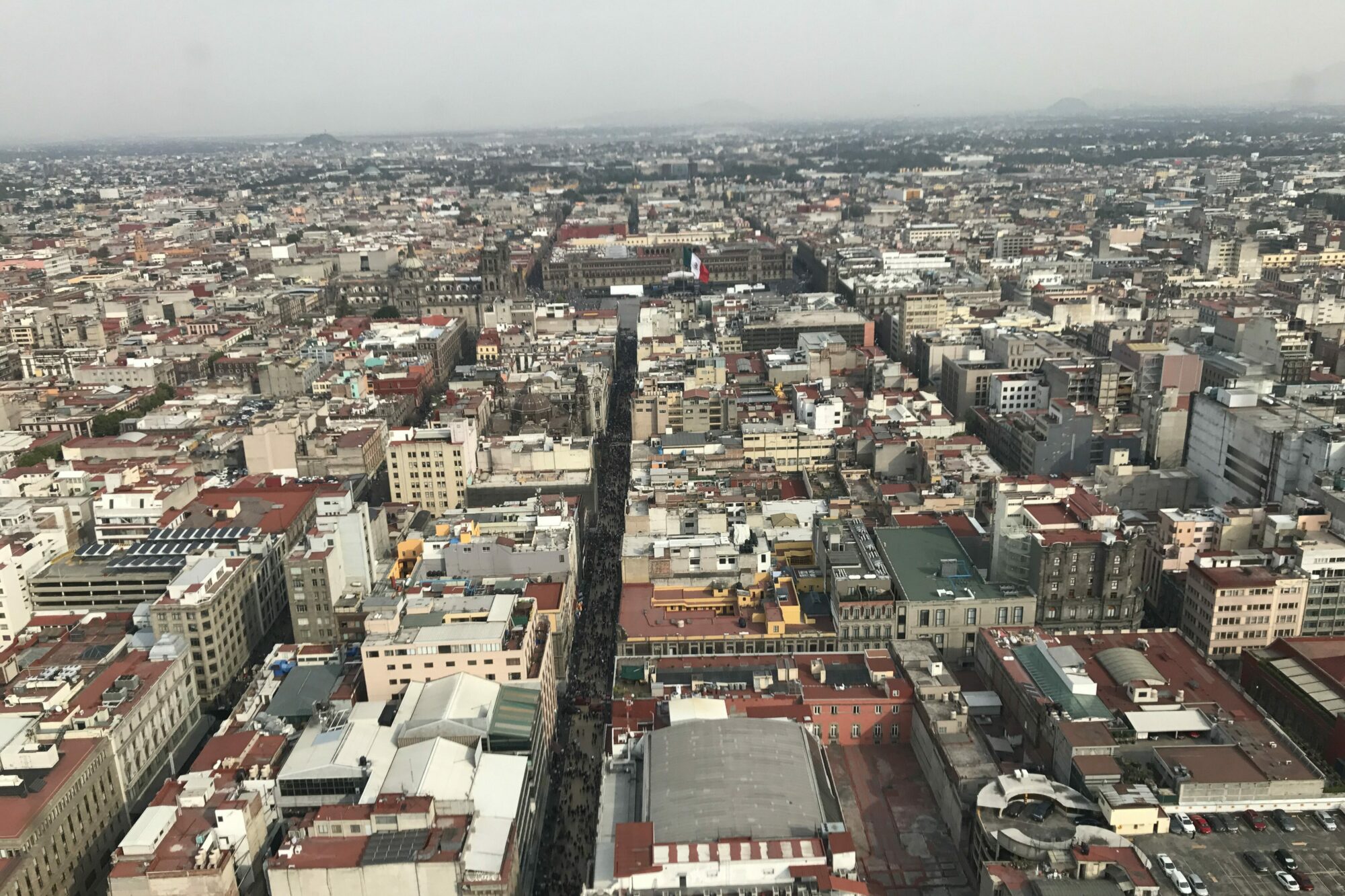
If you want the best view of Mexico City and the valley it sits in (so that you can imagine what it looked like as a lake years ago), you need to go to the top of Torre Latinoamericana, Mexico City’s first skyscraper.
You might be wondering, like we were, whose brilliant idea it was to build a skyscraper atop a swamp in a place known for massive earthquakes.
…well, we don’t really know (it was commissioned by an insurance company), but what we DO know is that it has now survived multiple big earthquakes (though it is sinking into the swamp).
As we were looking through their website (we didn’t do it on this latest trip, but we did a few years ago), it turns out that you actually can’t use a a foreign card to buy tickets in advance, which means you either have to buy them onsite (lines can be LONG, especially on weekends) or buy them through a third party (which they direct you to on their own website).
However, one big problem here – if you buy through a third party site, you STILL have to wait in line to exchange the voucher for a ticket, so it really doesn’t save you any time.
Given that, our best advice is to just buy tickets on arrival. You just want the mirador, not any of the museums. More information here.
Another option if the line is long – and we’ve done this – is to skip the mirador and just get a drink at the bar (called Miralto) near the top of the skyscraper.
It will cost roughly the same for a drink per person, and you get to completely skip the line and ride the elevator 40 floors up.
Choose Your Own (Mezcal) Adventure
To close out your first day, we have a choice for you.
Remember those fun choose-your-own-adventure books when we (millennials) were kids?
Personally, I remember the Goosebumps version, and would spend hours trying to do all of the different combinations, going back whenever I accidentally died in some horrific way to figure out how to do it differently so that I survived.
Anyway, the point is that we have a choose-your-own-adventure of sorts for you.
For a little bit of context, I have very fond memories of trying mezcal in Mexico City on that first trip and realizing just how different mezcal can be. In my mind, coming from the United States, it was ALWAYS smoky. No matter what.
But on that first trip, I discovered that it could be bright and citrusy, fruity, even floral. And, yes, it can also certainly be smoky. But it’s a wide flavor spectrum.
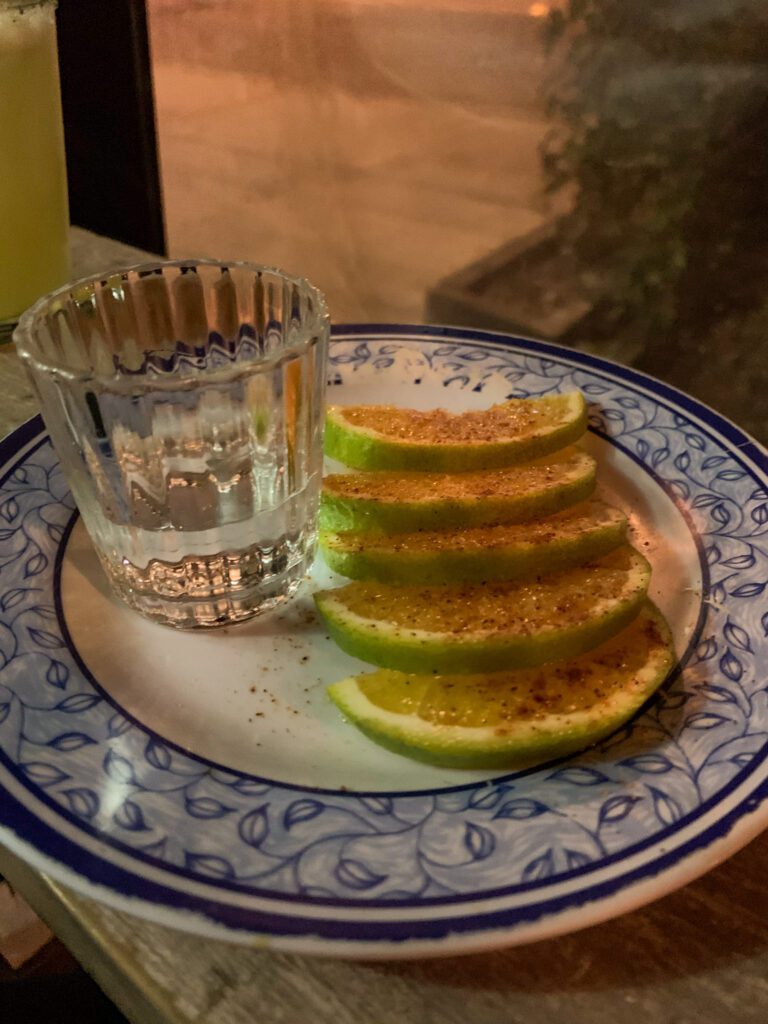
On the next trip to Mexico City, I decided that I wanted to go deeper, and we did a guided tasting of different mezcal varietals.
Of all the tours and experiences we’ve mentioned on this trip, I think this one is probably the most optional, which is why we’ve given you two options; that same experience that we did, and a DIY version that takes you to a few of our favorite mezcal spots in Roma Norte.
Which you choose depends on your budget and interests.
But either way, we think you should definitely invest a couple of hours in trying different kinds of mezcal, especially if you’ve only tried the smoky versions that you find in the US.
A Guided Mezcal Tasting
This is the guided mezcal tasting we did. We spent a couple of hours with a small group in an intimate setting in Roma Norte and tried five different mezcal varietals.
We started with an overview of mezcal – where it comes from, how it’s made, different regional variations – and then went into the five tastings, learning about the different varietals and what makes them unique along the way. At the end, we got a bonus tasting of a very special mezcal.
Even if you’re not super into drinking straight alcohol, which we certainly are not, this experience was a blast. It’s not cheap at $60 a person, but the value here comes from the explanations and curation of different mezcal varietals so that you can taste the differences.
One pro-tip for this experience: You need to eat a hearty meal beforehand. Five shots of mezcal (though you don’t drink them like shots, you “kiss” them and savor them) is A LOT of booze. In our old age, it would knock us out for several days, but luckily we did this experience in our younger days.
DIY Mezcal Tour
If you’d rather do a DIY version, we’d focus on three bars in Rome Norte that we’ve been to and enjoyed. They’re within a 10 minute walk of each other, and we’re going to present them in the order in which we’d recommend them for the mezcal, specifically.
La Clandestina: Our OG recommendation, we’ve been here across three different trips now. It’s not a particularly curated experience, but they have an EXTENSIVE menu of mezcals ranging from tame Espadins to wild ones from Jalisco (versus Oaxaca, which is where most mezcal comes from). They also have a Kiwi Mezcal cocktail that is one of the best cocktails I’ve ever had in Mexico City.
Mano Santa: Another mezcaleria in Roma Norte, this one is similarly intimate to La Clandestina, with seating that spills out onto the sidewalk in front. They have a wide-ranging selection of mezcals, including different varietals and some fun experimental processing. They also have a food menu heavily featuring Oaxacan food (get the tlayuda).
Mis Mescales: At the time of my previous visit, Mis Mezcales was my absolute #1 recommendation in terms of buying mezcal to take home. Great selection, friendly and helpful owner, and an easy location in Roma Norte. Imagine my disappointment when, as I was putting together this guide sitting in the Mexico City airport about to fly home, I learned that they do GUIDED TASTINGS now, and I missed it! It’s about $20 USD, and includes about four mezcals to try in their intimate space near Mercado Roma. More information here.
Day 2: Chapultepec Park, the National Museum of Anthropology, and Polanco
The bulk of your second day in Mexico City will be dedicated to a history lesson spanning thousands of years, from the Mayans and Aztecs to present-day Mexico (and everything in between).
Don’t worry, all that learning will be sandwiched by coffee in La Condesa, a walk in Mexico City’s version of Central Park, and an evening in Polanco, Mexico City’s glitziest neighborhood.
IMPORTANT NOTE: These museums are closed on Monday, so if this day happens to fall on a Monday, swap it with one of the other days!
But First, Coffee in La Condesa
Before the day begins in earnest, you’re going to want (read: need) some caffeine to get you through the two museums on the agenda for the day.
Lucky for you, the northwest corner of La Condesa, which is near your first stop in the park, is a great place to find good coffee.
Here are three options for getting your day started.
Camino a Comala: This was a recommendation from the leader of our coffee experience, Christian, and it certainly did not disappoint.
The best cup (really, tied for best cup) of coffee in Mexico City that I had came from here – a gesha from famed Finca Chelín in Oaxaca – that was all florals, both in the cup and on the nose.
They also have other, less expensive coffees available for pour over, or your usual range of espresso drinks.
Anvil Café: A tiny space on the ground floor – similar to the size of many a tortilleria in Mexico City – this place is worth a stop for their horchata espresso alone, which I saw on the menu and immediately texted my older brother to tell him to meet me there to try it (spoiler: it was great).
I asked the barista all sorts of questions (in semi-competent Spanish) about their brewing methods, and he was super helpful and friendly as he walked me through what he was doing to prepare my pour over.
They have limited seating on the sidewalk, and exactly three seats at the bar inside.
Blend Station: I have mixed thoughts about Blend Station. Let’s start with the positive – their space in La Condesa, which presents as a typical espresso bar as you enter, but opens up into a big, beautiful atrium as you get to the back wall – is beautiful. If I had to pick one coffee shop to hang out in, it’s probably this one.
However, I wasn’t the biggest fan of their coffee. In fact, I would call it a 50% hit rate – loved one of two of the coffees I had there, and then we bought two bags to bring home and I also loved one out of two of those.
On a later trip, I had an espresso tonic, which was actually lovely. Pros and cons, I suppose.
Chapultepec Park, Chapultepec Castle, and the National History Museum
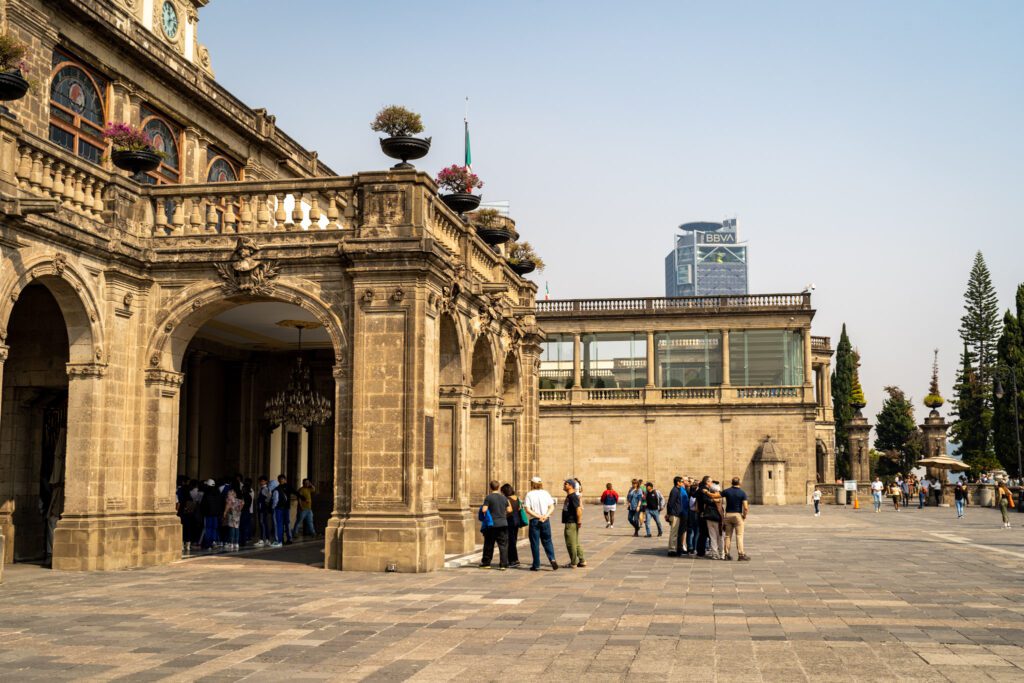
This was another discovery on our latest trip to Mexico City in 2023, and I can’t believe we didn’t choose to come here on any of our previous trips.
It has everything we like! Great views of the city, a history lesson (albeit in Spanish), and a couple of gorgeous murals.
Chapultepec Castle is in the middle of Chapultepec Park, perched on top of a hill with a great view of the surrounding city (at least when the smog isn’t so thick you can barely see Polanco).
It was originally built in the late 18th Century as a palace, which isn’t surprising given that incredible view.
Over the years, it has been a palace, a military base, and most recently, a museum. Among many other things.
Today, it houses the Museo Nacional de Historia, or the National History Museum.
While the Anthropology Museum is going to give you a view into the area’s history before the existence of the state of Mexico, the National History Museum is going to give you the story of Mexico from its establishment as a Spanish colony to present day.
It’s laid out in (mostly) chronological order, and the highlight of the museum for me is the huge murals that tell the story of events from the War of Independence (from Spain), Revolution (against the dictatorship of Porfirio Díaz), and the Mexican-American war (when American forces took the castle by force, suffering heavy casualties in the process).
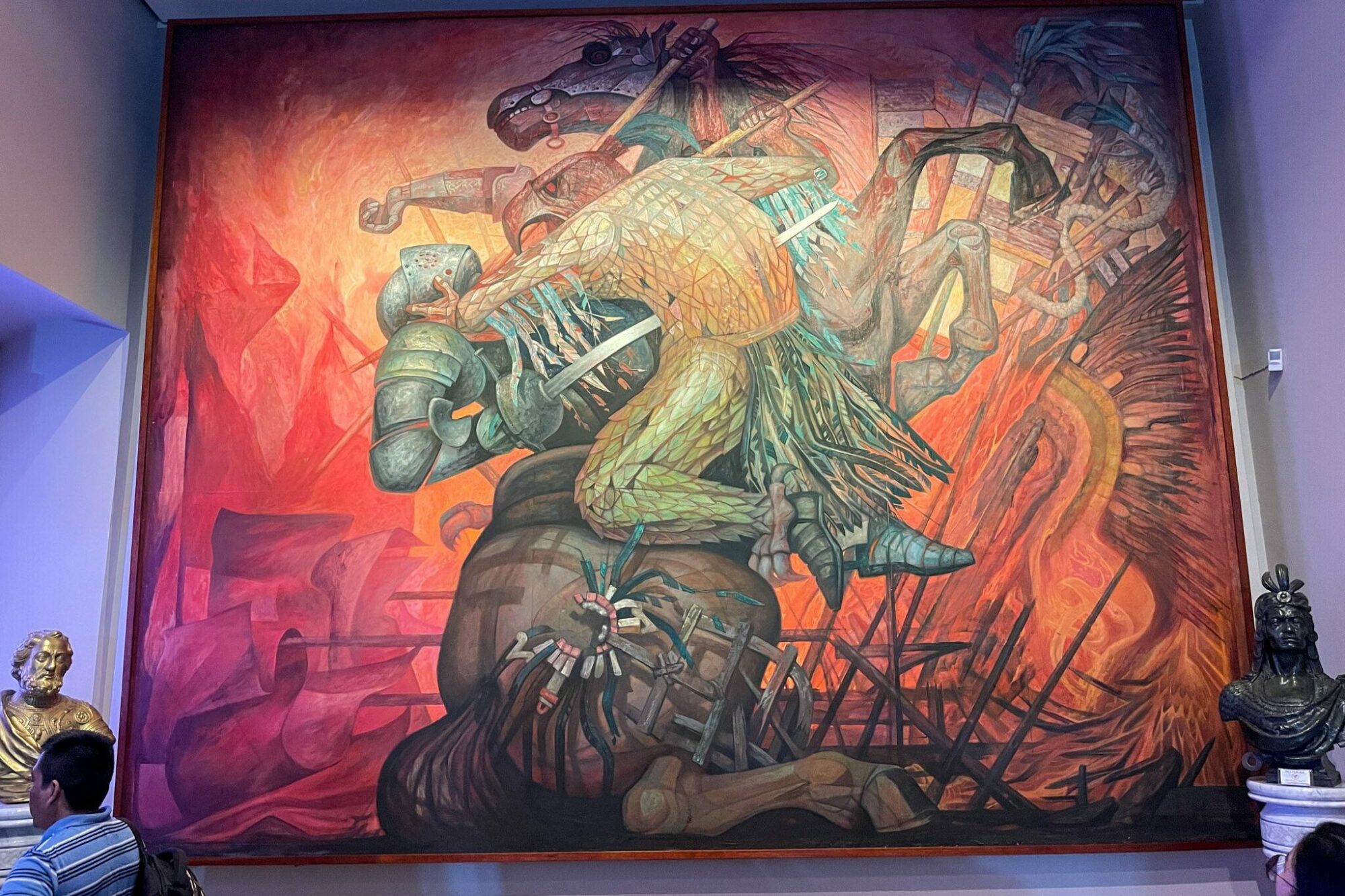
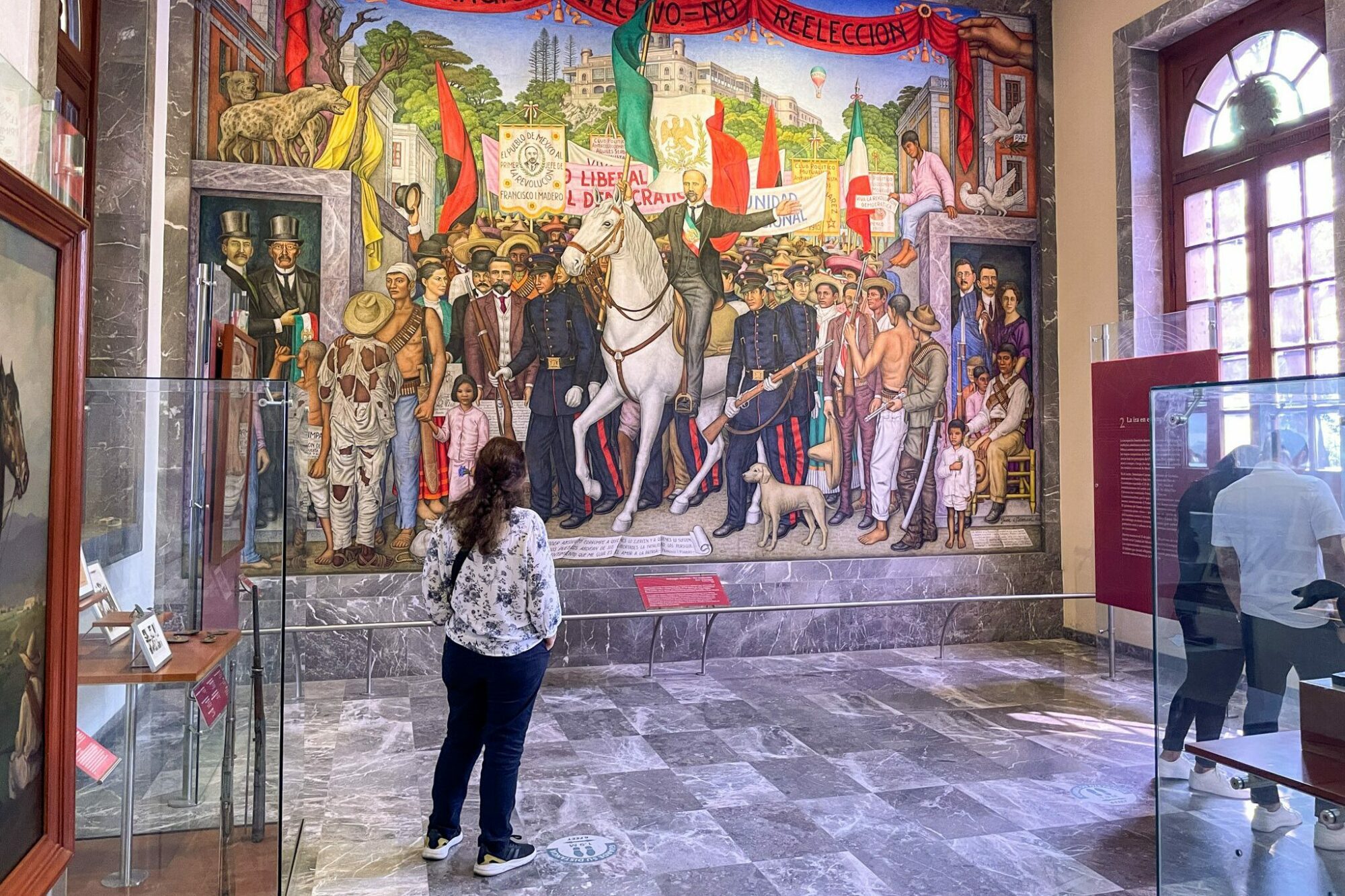
Overall, the museum will take you somewhere between 60-90 minutes to cover, including the historical exhibits and taking in the views.
Most of it is in Spanish, but even if you can’t speak the language, a lot of it is visual, so it’s still worth your time.
You can buy tickets onsite, and they cost 90 pesos (at the time of writing). Find the most-up-to-date information on opening hours, prices, and more here.
An important note: You cannot bring bags bigger than a small backpack (I tried to ask how big is too big and didn’t get a real answer) or any food and drinks into the museum, otherwise you will have to check your bag. IF YOU NEED TO CHECK YOUR BAG, YOU NEED TO BUY A TOKEN FROM THE TAQUILLA (TICKET OFFICE), AND IT COSTS 10 PESOS.
El Museo Nacional de Antropología
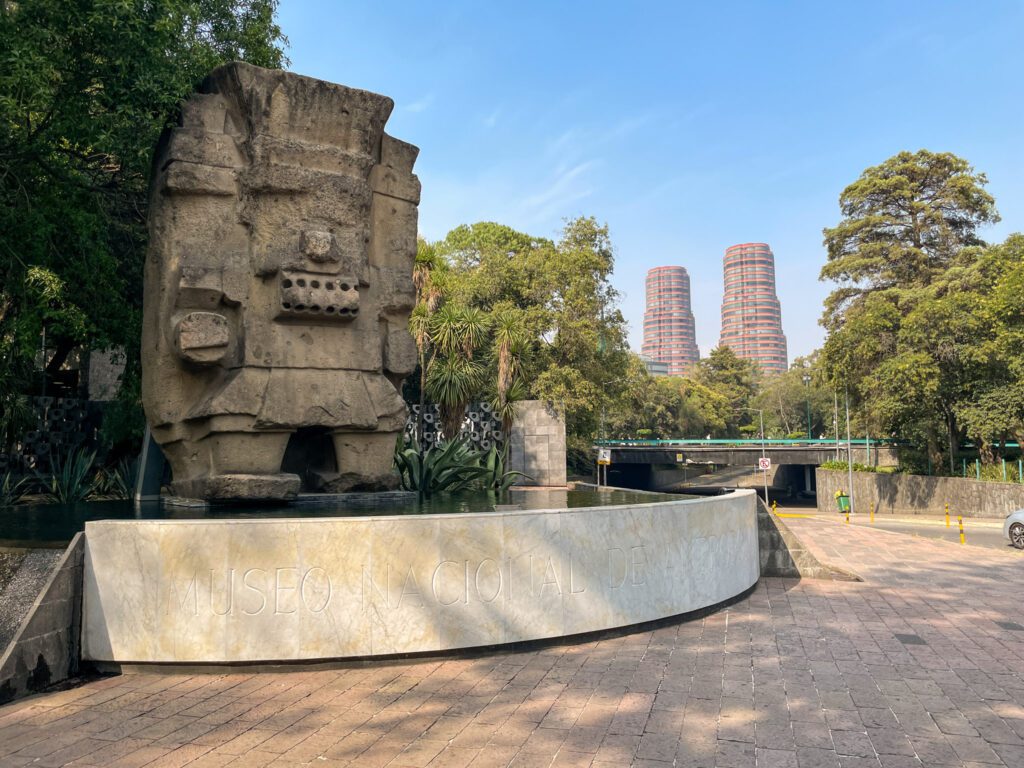
Of all the things we’re covering on this itinerary, we feel the most sure about our take on the Museo Nacional de Antropología – which we’ll be calling “the Anthropology Museum” from now on.
The Anthropology Museum is one of the most prestigious museums in Mexico City, and for good reason.
It covers thousands of years, with precious artifacts that tell the story of Mexico, with a strong focus on the indigenous people who have called it home for all those years.
While we did learn about the Mayans and Aztecs in school in the United States, it was essentially a couple of paragraphs on each, which is not nearly enough time dedicated to two of the most important civilizations in the history of the Americas.
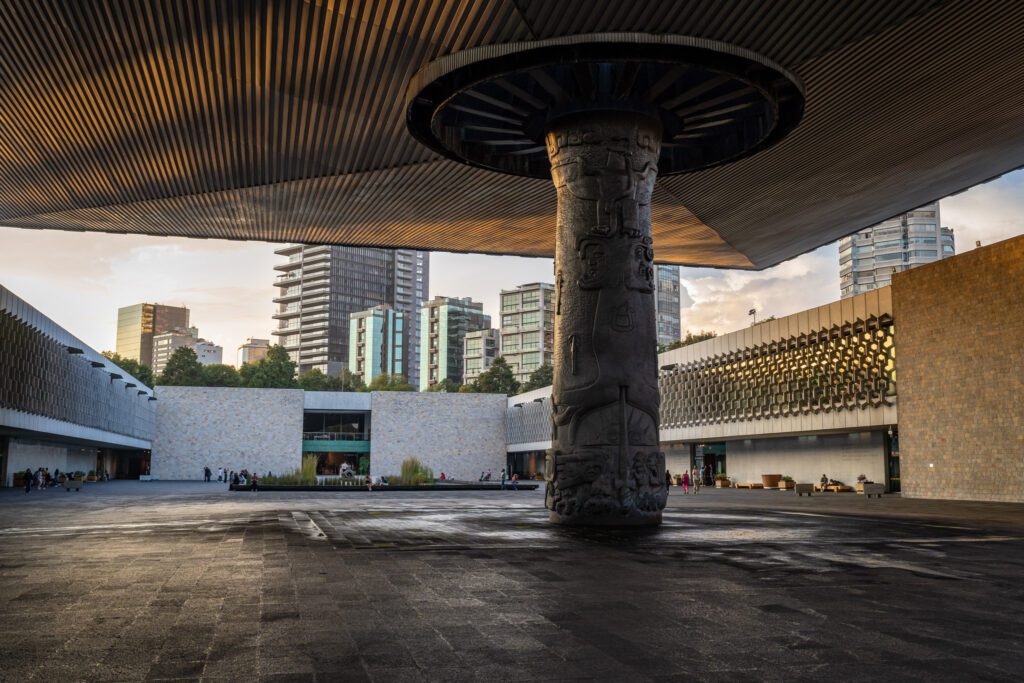
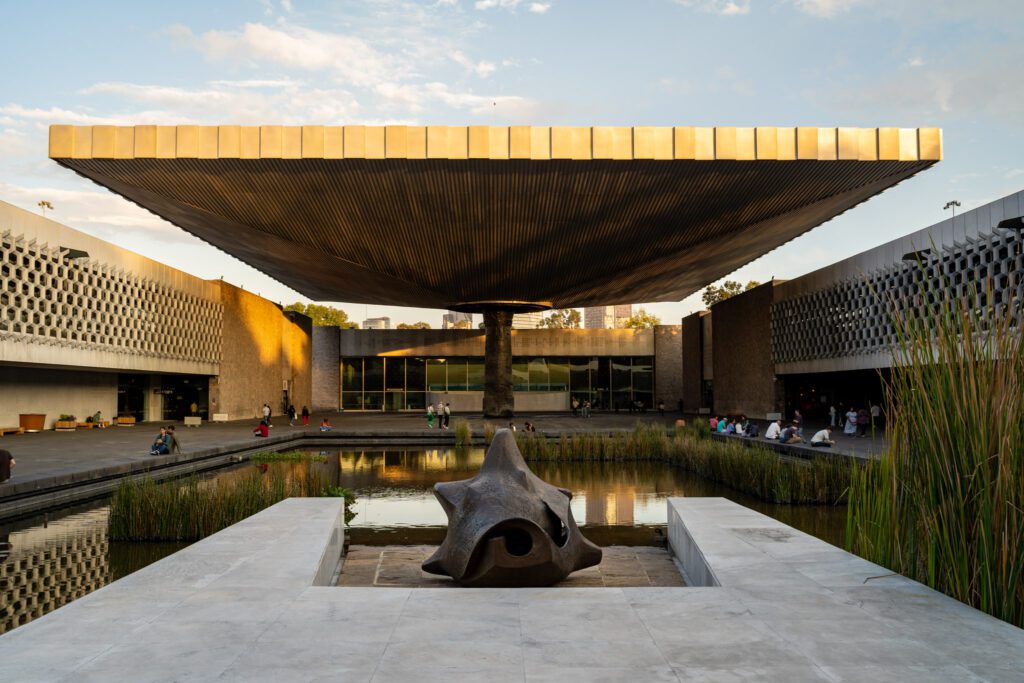
But first, let’s talk about our museum philosophy for a second. And to do that, it makes sense to go all the way back to our very first trip to Mexico City back in 2017.
At that point in our lives, we were just young spring chickens who hadn’t traveled all that much and Matt didn’t really speak Spanish (both of those things have since changed).
We went to the Anthropology Museum at opening time on one of our precious four days, and learned an important lesson; we’re not particularly good at museums.
That has been borne out since at various museums around the world, and we’ve found that for us to really understand what we’re seeing, we need someone who is smarter and more knowledgeable than us to tell us a story.
Otherwise we just kind of wander around, saying things like “oh that’s pretty” and “oh cool, a snake.”
Here’s the take that we’re sure about: If you can afford it (it’s not terribly expensive), you should absolutely only do the Anthropology Museum with a guide.
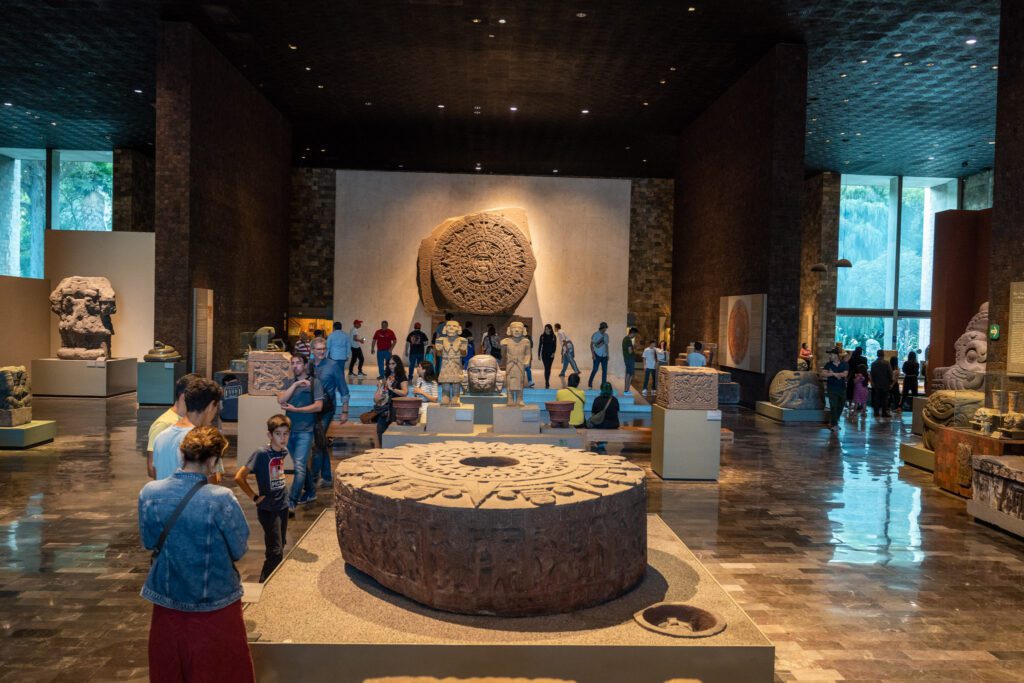
There are a few reasons for that, but there are two important ones that we want to call out.
First, it is absolutely massive, with 22 rooms full of precious artifacts ranging thousands of years. It would take more than a full day to see it all, and how do you know what to focus on? Spoiler: that’s where a guide can help!
Second, almost everything is in Spanish (with a few English explanations per room, but most are giving broad historical context and there are very few explanations for specific artifacts).
Even though we’re pretty comfortable with Spanish after a month in both Mexico and Spain (which might as well be different languages) and two months in Colombia over the past several years, we had a hard time comprehending some of the signage because it’s full of words we don’t usually see conversationally.
Visiting the Anthropology Museum on a Guided Tour
We did this tour with Carlos, which was another highlight of the trip.
We spent three hours with Carlos focusing on the Maya, Aztec, and Teotihuacan rooms, and he weaved together a narrative that tied the three civilizations together and helped us understand what we were seeing in a way that we definitely didn’t put together on our own.
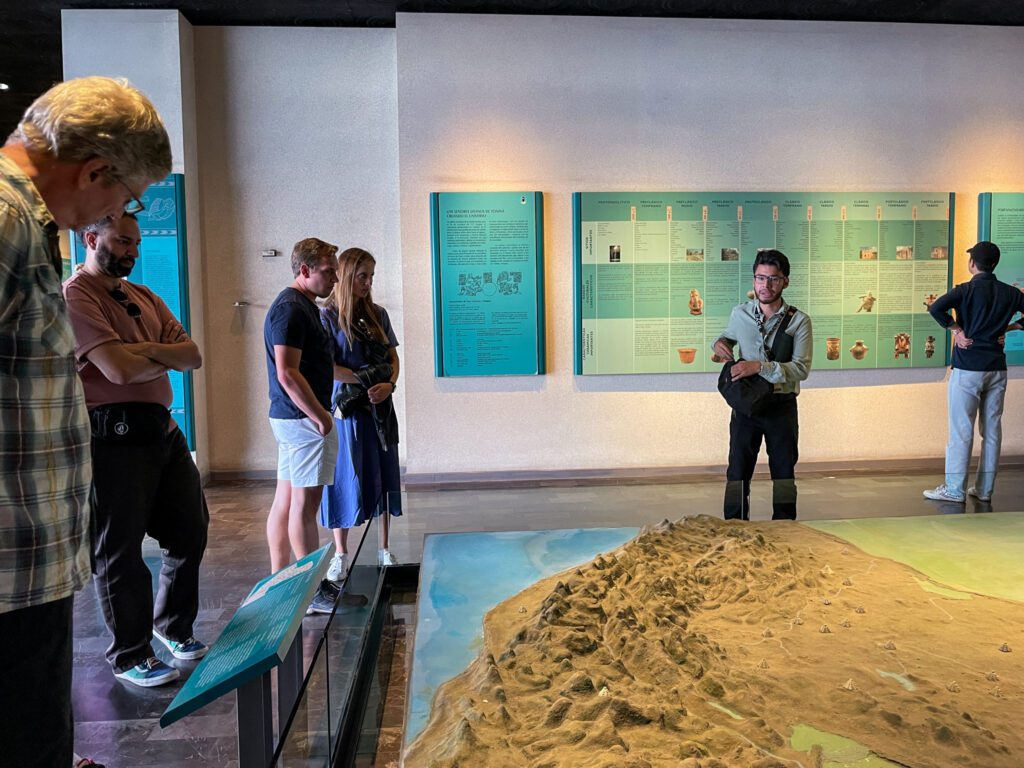
One of the most interesting things I learned, at least to me, is the reason behind the fact that many Mayan ruins seem more worn, while Aztec ruins look like they could have been built last week.
Mayans were using limestone, which is more apt to erode due to weather and other conditions, while Aztecs used more basalt, which is more hearty.
Our point is that the Anthropology Museum is absolutely worth seeing (and makes a nice pairing with the National History Museum nearby), but various factors make it a hard museum to do on your own.
So you should take a guided tour if you want to get the most out of your time exploring it.
Click here to see prices and availability for the same Anthropology Museum tour we did, which is worth every single peso (and includes entry).
Doing the Anthropology Museum on Your Own
If you are going to do it on your own, there is an English audio guide that is going to be worth it.
The other thing to consider is what time of day you’re visiting. We’ve been in the morning and the late afternoon, and preferred the late afternoon (which is when the tour takes place) because it is far less crowded, especially with school groups who tend to visit in the morning.
If you can, go in the afternoon a few hours before closing (which is how we’ve structured this itinerary).
We’d suggest buying tickets in advance (once you’re in Mexico City is probably fine), which you can do here (the “buy tickets” button is on the top bar, and you can switch the website to English using the “ES/EN” toggle at the top).
An important note: You cannot bring bags bigger than a small backpack (I tried to ask how big is too big and didn’t get a real answer) or any food and drinks into the museum, otherwise you will have to check your bag (which is both free and safe). However, the bag check line is LONG, so we’d do our best to avoid bringing a big bag with you on this day, if you can.
Feast in Polanco
As we already mentioned, Polanco is the place to see and be seen in Mexico City.
Straddling the north side of Bosque de Chapultepec, it’s full of relatively expensive boutiques, nice restaurants (including two of the top 15 restaurants in the world), and plenty of fancy bars.
It’s worth spending an evening soaking it up, especially if you’re into fine dining (more on that in a second).
We have three specific recommendations for you in Polanco, though there is a ton more to do, see, eat, and drink (in particular, the modern art at Museo Soumaya is worth a trip if you have more time in the city).
First, if you’re into fine dining, this is your moment.
Two of Mexico City’s most highly acclaimed restaurants are within a few blocks of each other in Polanco.
If you’ve ever watched a food show about Mexico City on Netflix, you’ve no doubt become familiar with Enrique Olvera, whose empire stretches from Mexico City to New York City now. His main squeeze, Pujol, is the one you’ve undoubtedly heard about.
The other is Quintonil, and the chef trained under Olvera before starting his own thing. We’ve experienced both now, and they’re different.
.Pujol is more traditional and understated,
Quintonil is more adventurous and, dare we say flamboyant?
In general, you’re going to have a hard time getting a table at either (make reservations months in advance), but if we had to choose, we’d say Quintonil for the adventurous take on Mexican food.
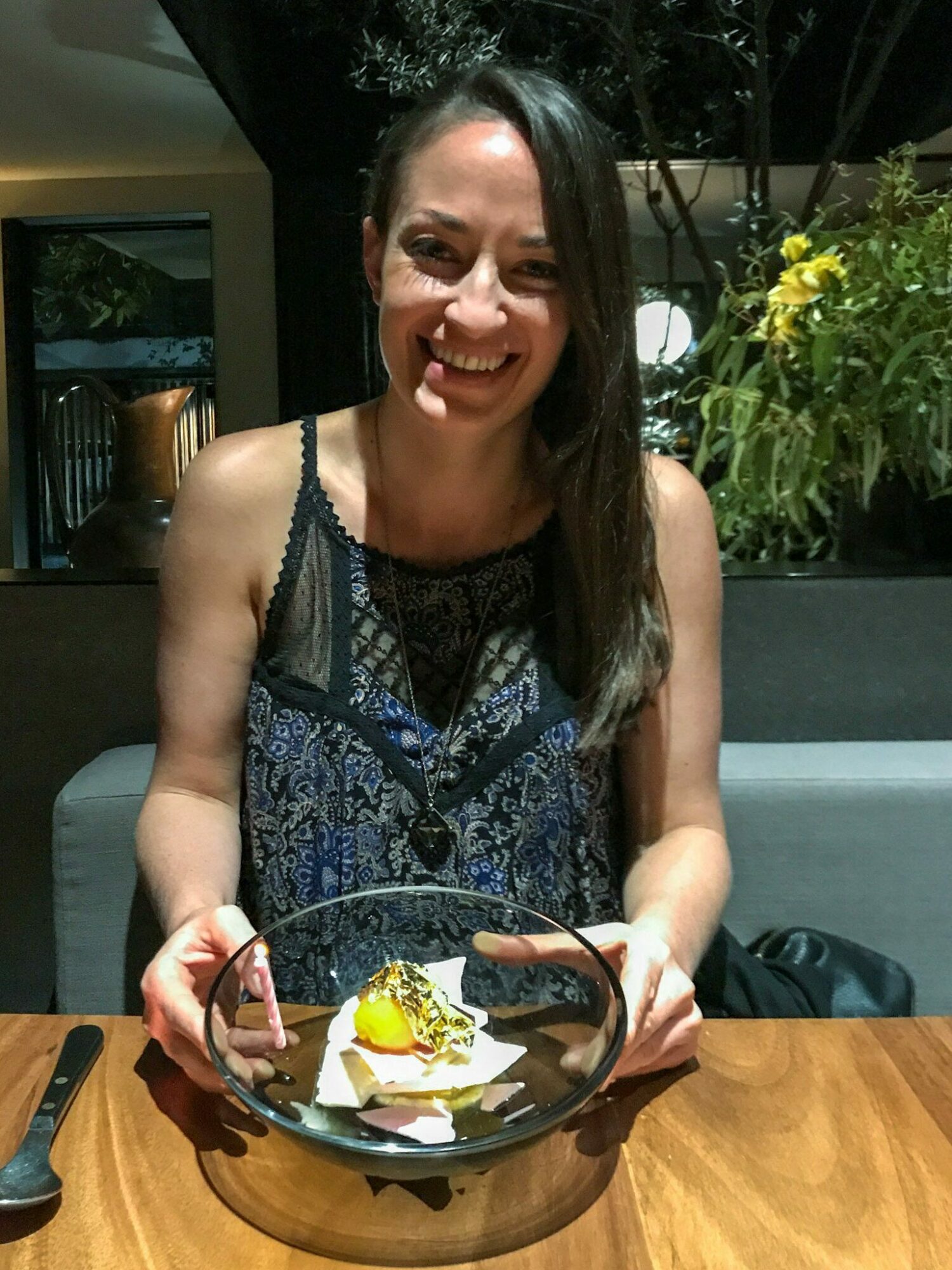
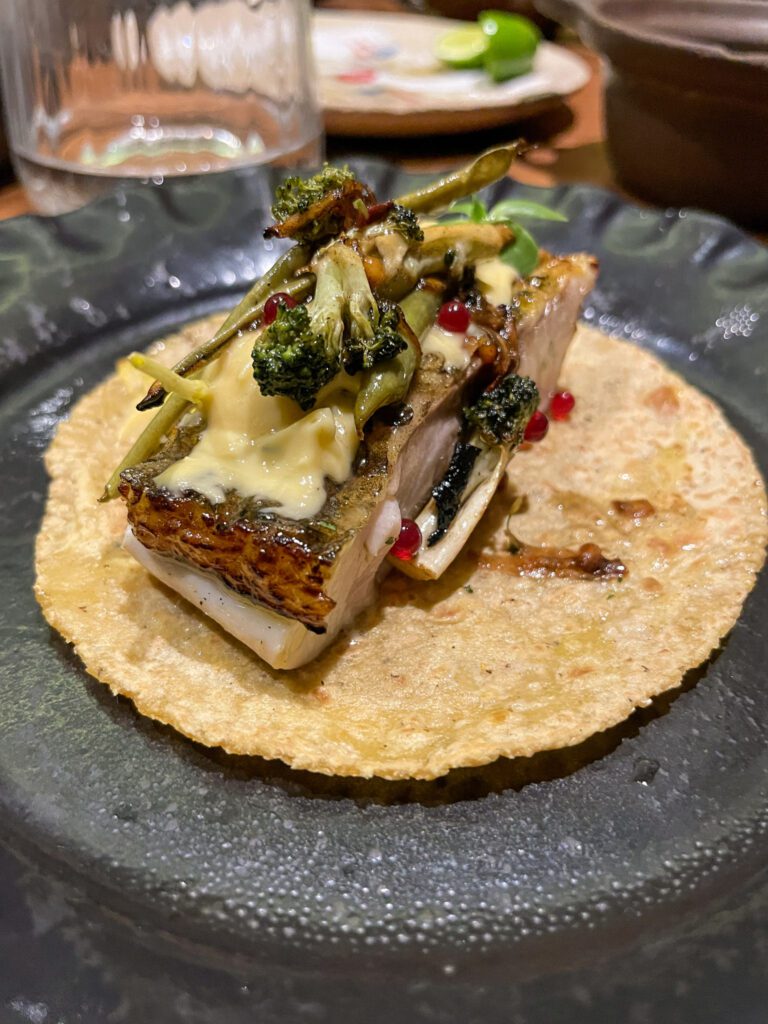
Second, Limantour absolutely lives up to the hype. It’s a cocktail bar that always shows up on lists of “the world’s 50 best bars” and, while we can’t say whether or not that ranking is deserved, we CAN say that we’ve been here multiple times, and always enjoy the drinks.
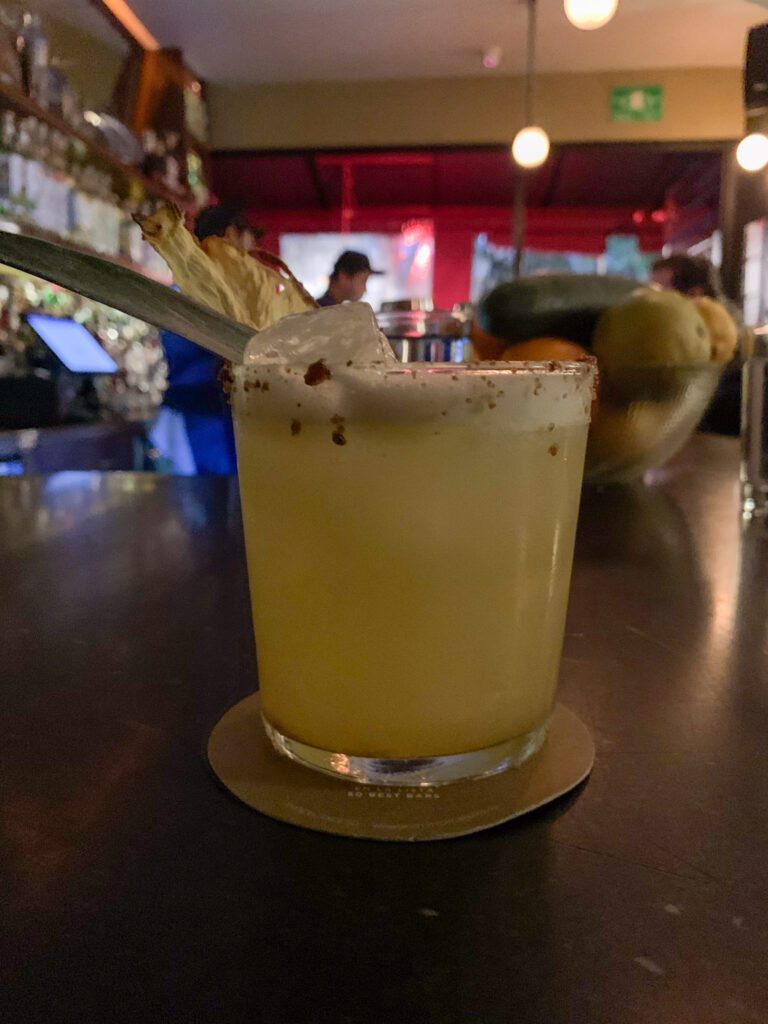
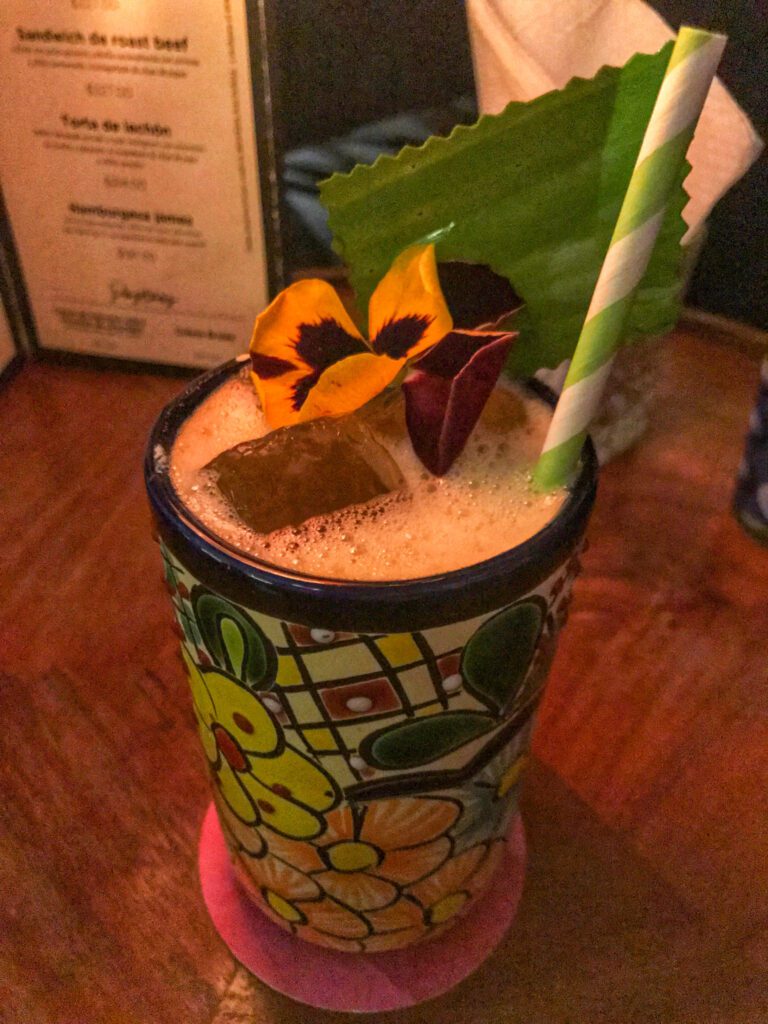
Third, you should absolutely spend some time wandering and window shopping. Polanco is a great place to shop, and it has everything.
Our recommendation would be to start at Pasaje Polanco (here on Google Maps), which has a nice selection of shops, and work your way around the neighborhood from there.
Day 3: A Cooking Class, Roma Norte, and La Condesa
On your third day in Mexico City, spend the bulk of your morning immersed in Mexican food culture by taking a cooking class that includes a market tour in Roma Norte.
Then, after your food coma wears off, head out to explore the rest of Roma Norte before ending your day in leafy La Condesa.
A Cooking Class + Market Tour at Aura Cocina
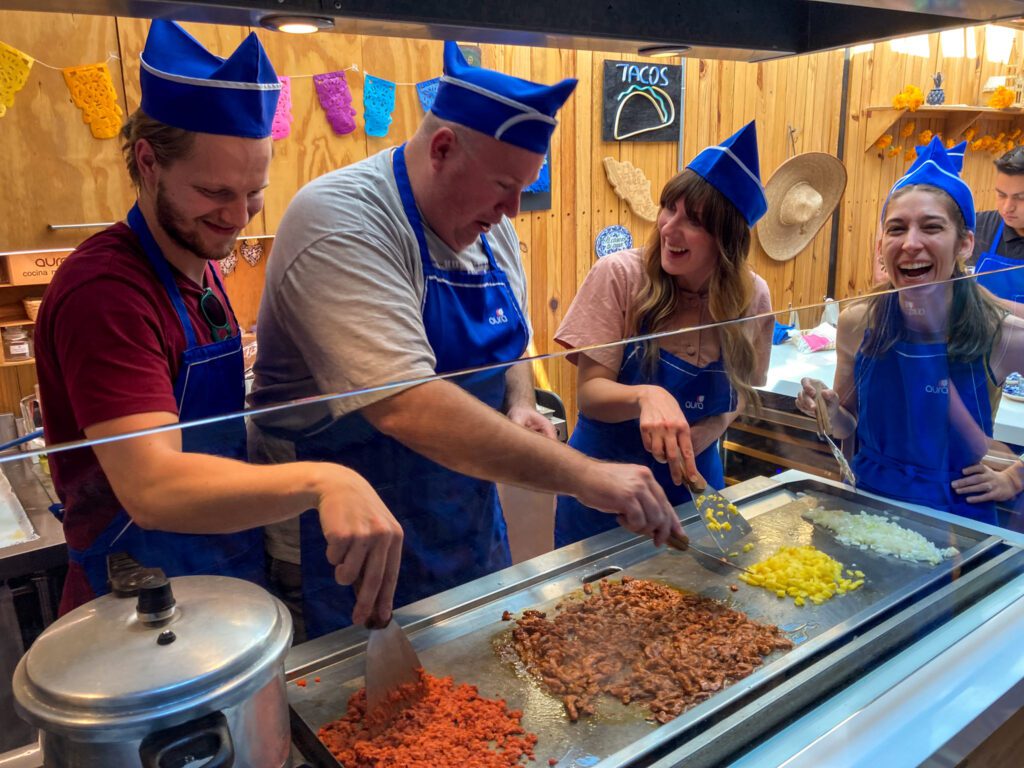
We’ve already waxed poetic about the value of a museum tour above, but you know what else we absolutely love doing while we travel? Cooking classes (or food tours).
Cooking classes and food tours are our favorite way to delve deeper into the food culture of a place we’re visiting, and they also generally leave you with a souvenir of sorts: recipes you can make at home!
I kid you not – as I’m writing this at our home in Portland, we have a taco recipe on the stove that I got from our cooking class in Mexico City a couple of weeks ago.
In this case, having done both a cooking class and a street food tour in Mexico City, we’d opt for the cooking class if we HAD to choose (though, it’s worth noting that the street food tour is our first item in the “with more time” section).
We especially love these types of experiences if they include a market tour, because we feel the same way about market tours as we do about museums – we don’t always really know what we’re looking at, and having a local to help us understand cultural context is extremely helpful.
Otherwise, we’re kind of wandering around going “oh that’s a cool looking fruit, wonder what that is” and moving on after 15 minutes or so.
I, Matt, have now done two separate cooking classes at Aura Cocina, a cooking studio in Roma Norte, and absolutely loved them both and think it’s an important piece of any itinerary for Mexico City.
And I happened to have the same chef, Lorena, leading the class who I learned during the second class is the sister of the founder of Aura, Graciela.
It’s a solid five hour affair, but you’ll barely notice the time flying by.
Here’s what the day is going to look like, at a high level. You’ll meet early – around 9:30am for the version with a market tour – at their gorgeous newly remodeled studio in Roma Norte, where you’ll be greeted, offered coffee and a snack, and given some context for the class.
From there, you’re whisked away to nearby Mercado Medellin to walk through and discover some fruits, flowers, both corn and flour tortillas, and some special treats from Oaxaca (no spoilers).
Then, you return to the studio and the cooking begins! Around 1pm, after an hour or two of active cooking, you’ll be ready to eat!
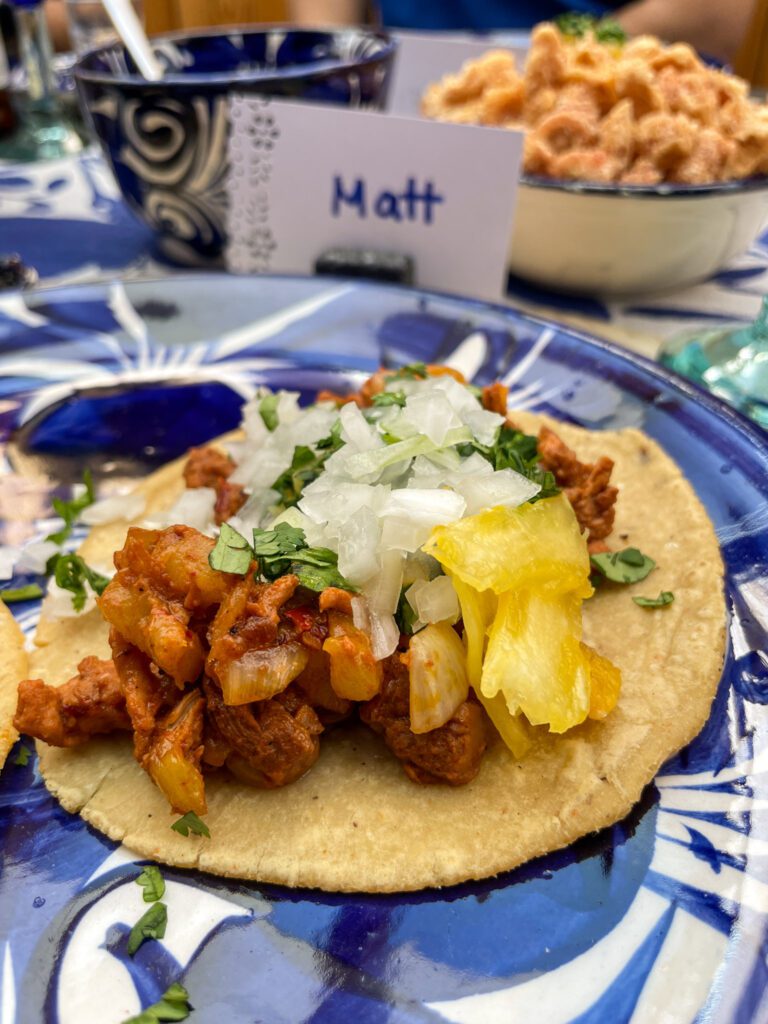
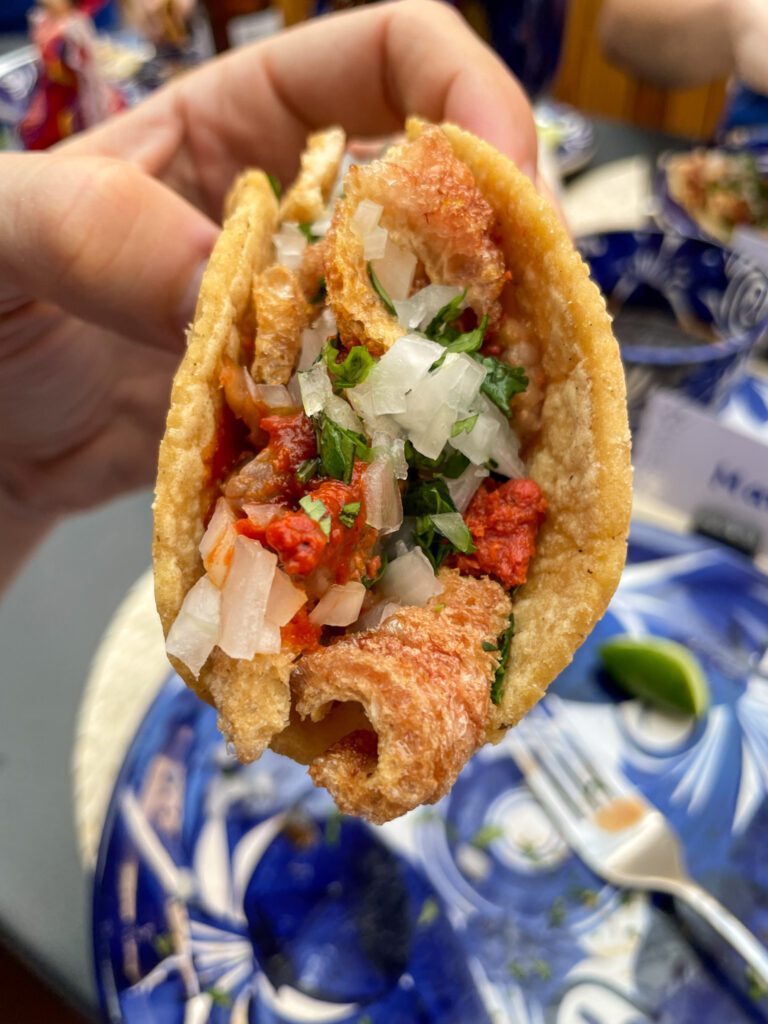
They have a wide range of different classes, and I have personally done (and loved) both their street tacos class, which covers three different types of tacos along with a salsa for each, and their four course Mexican feast, where we cooked a white mole and a tlapique, two things I had never heard of or experienced before then.
If I had to choose, I think I’d go for the Mexican feast because the recipes are more unique, but I also really enjoyed the tacos experience and it’s very close. You can’t really go wrong either way.
Exploring Rome Norte
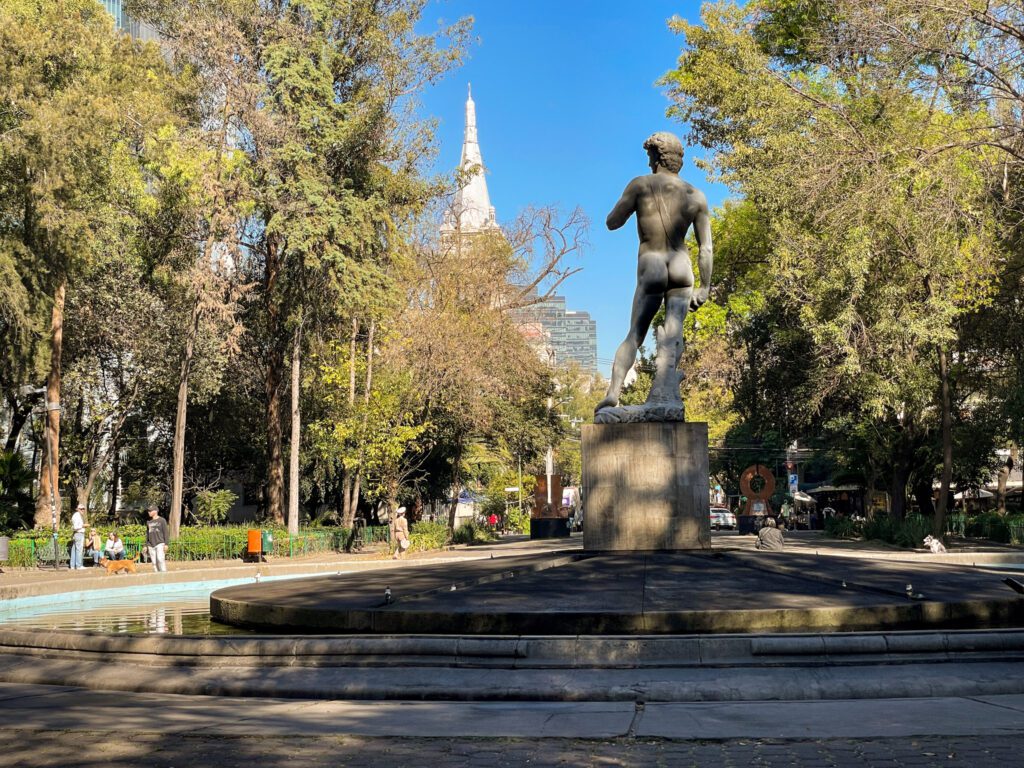
Roma Norte is one of our favorite neighborhoods in Mexico City, and leads the list of our recommendations of where to stay in Mexico City.
Colonia Roma is a historic neighborhood that sits just southwest of Mexico City’s Centro Histórico. Unlike La Condesa, which is a little more free-flowing in terms of its urban design, Roma Norte is laid out on a grid, which is a nod to its relatively modern creation.
As you walk around Rome Norte, you might notice that it feels fairly European, with a few wide boulevards and tree-lined streets with shops, cafes, and restaurants on the ground floor and apartments on the top floors.
There’s a reason for that: it started as a wealthy suburb (of sorts) just outside the city center where wealthy aristocrats – mostly Europeans – gathered.
Since then, it has had a few ups and downs. Namely in the 1980’s, when it went through a rough patch that ultimately paved the way for it to become what it is today: one of the hippest, most desirable neighborhoods in the city (particularly for expats and tourists).
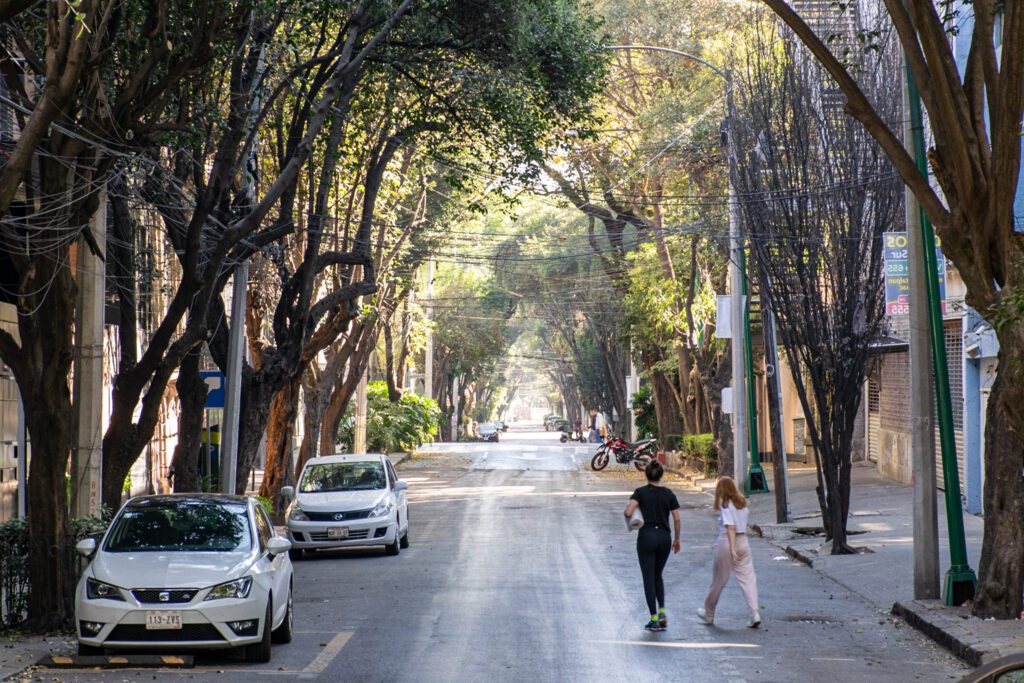
It’s a classic case of gentrification that we’ve seen in cities we’ve lived in and visited around the world.
The neighborhood becomes less desirable and, therefore, cheaper, which means artists and the bohemian crowd moves in and makes it hip, and then it gets more and more expensive, pricing out the bohemian crowd that made it cool in the first place.
A tale as old as time. It’s something to keep in mind as you explore Roma Norte, because it has meant that the businesses and housing here has become so expensive that it is borderline unaffordable for many lifelong residents.
That doesn’t mean you shouldn’t visit, but you should be conscious of the impact that gentrification has had on the neighborhood and be respectful.
All that being said, here are our favorite spots in Roma Norte (excluding the mezcal spots we mentioned above on day 1, which are worth visiting if you didn’t do them then).
- Expendio de Maíz Sin Nombre: Probably our favorite place to eat in Mexico City, this has been a fun experience both times we’ve been (though the service was better on our first visit in 2019). This restaurant is, essentially, an open kitchen inside a garage that puts out a menu-less avalanche of delicious food based around their handmade tortillas, which are made with nixtamalized corn rather than mass-produced corn flour. It’s worth reading this great Culinary Backstreets piece about them for more context, and this piece about the death of the centuries-old nixtamalization process. Essentially, you sit down, tell them if you have any dietary restrictions, and then they bring you one course. After that course, they’ll ask if you want more. Rinse and repeat until you’re stuffed. Most of the food is relatively simple, but the high quality ingredients speak for themselves and make each dish an explosion of flavor.
- Pulqueria los Insurgentes: For a different, more low key, more hip version of a pulqueria, this is the spot. It’s a multi-floor bar with a different vibe on every floor.
- Panadería Rosetta: The most famous bakery in Mexico City? Probably, at least with expats and tourists. Since our previous visit, they’ve expanded big time into a bigger space next door with a sidewalk patio. Pro-tip: there’s always a long line to eat there, so get in the fast-moving line to get pastries to go and take them to the park around the corner (more on that a few bullets down).
- Cardinal Casa de Café: The cup of coffee that was tied for our favorite cup in the city was brewed here on a slow Sunday morning. I asked the barista / manager for a recommendation for V60, and he had an immediate answer that did not disappoint. Plus, the best specialty drink we had was the Voltaire, which is essentially a cappuccino with chocolate. YUM.
- Tlecan: An accidental discovery on an impromptu cocktail crawl in Roma Norte / La Condesa, this place has excellent (if a bit expensive) cocktails. Get the mezcal negroni – it’s a banger.
- Plaza Río de Janeiro: Our favorite park in all of Mexico City? It’s close. Between the fountain, the replica of the statue of David, and all of the dogs running around, we found ourselves here multiple times across all of our trips, and it’s a pleasure every time. Get pastries from Panaderia Rosetta and bring them here to avoid the madness that is the sidewalk immediately in front of the bakery. It’s here on Google Maps.
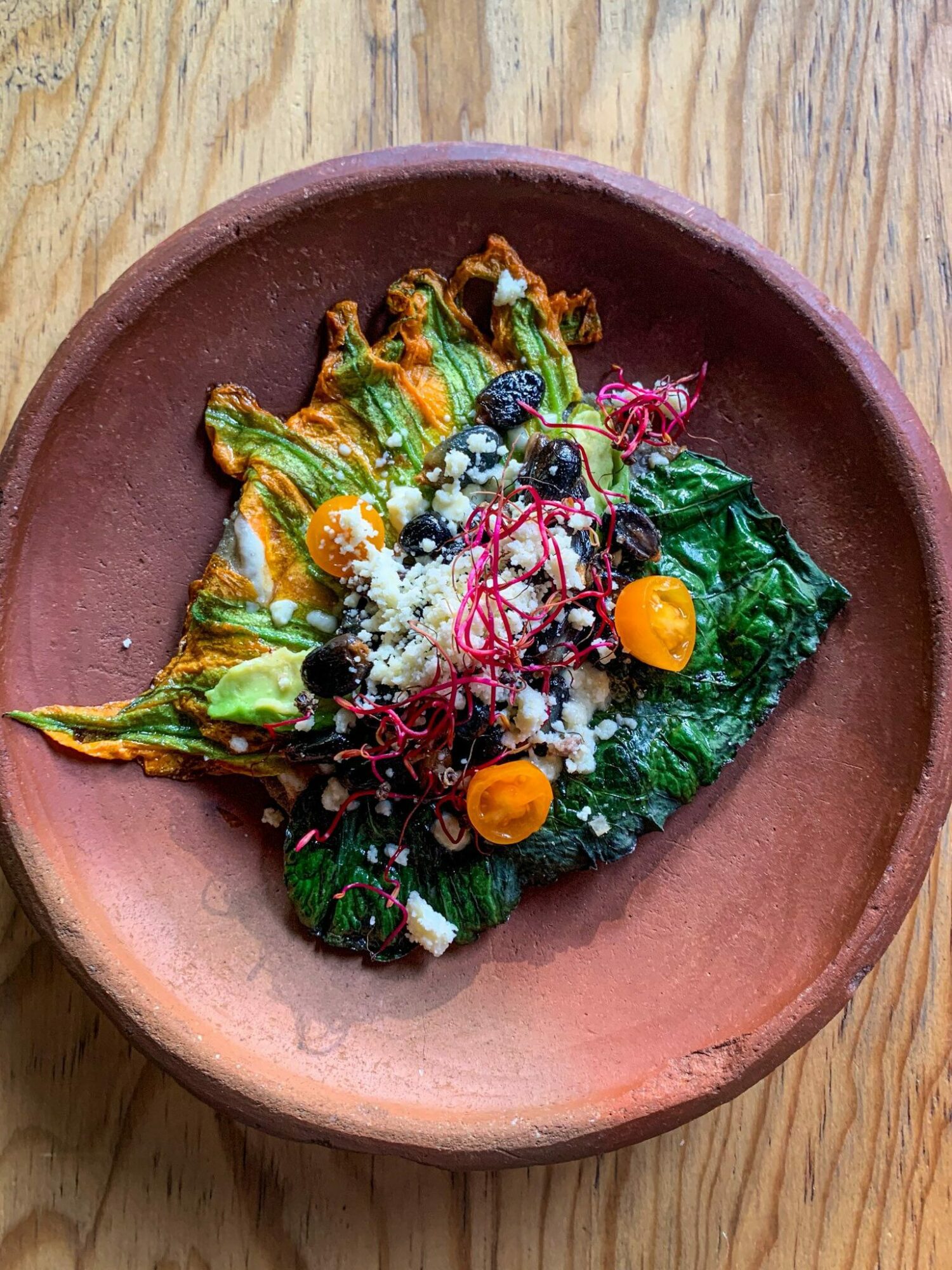
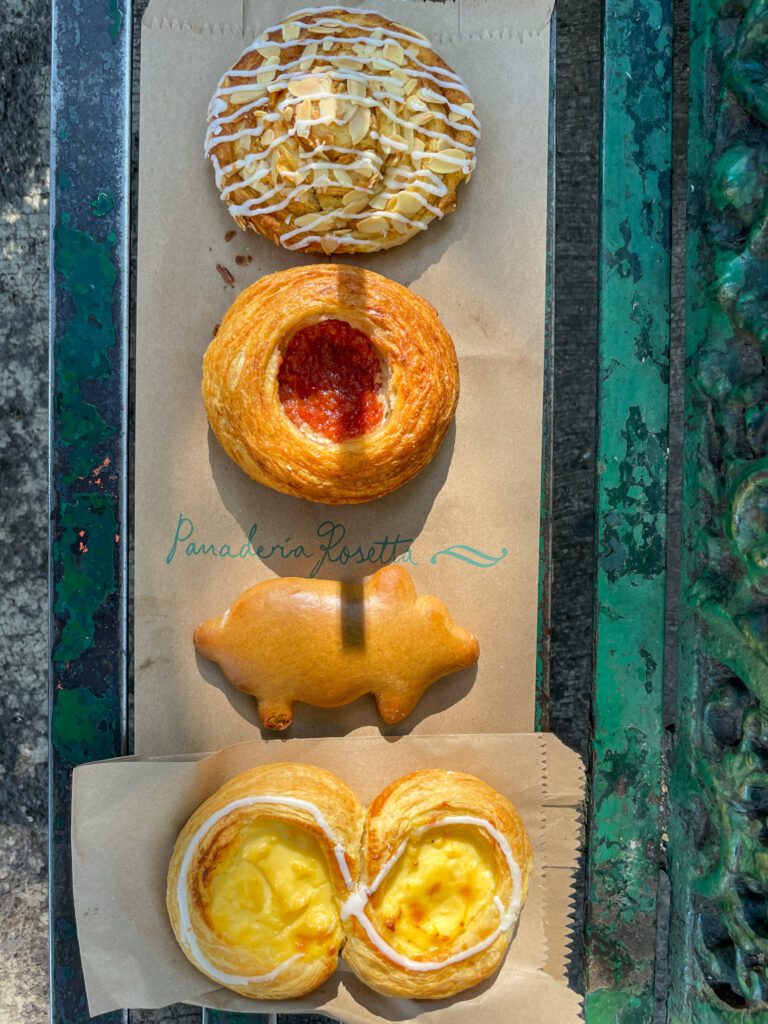
An Evening in La Condesa
In many ways, La Condesa and Roma Norte are fairly similar. They’re upscale, leafy, and the places where you’ll hear the most English in Mexico City because they tend to be full of tourists and expats.
However, unlike the logical grid layout of Roma Norte, La Condesa is a maze of tree-lined streets that is centered around the two parks at the heart of the neighborhood: Parque México and the smaller Parque España.
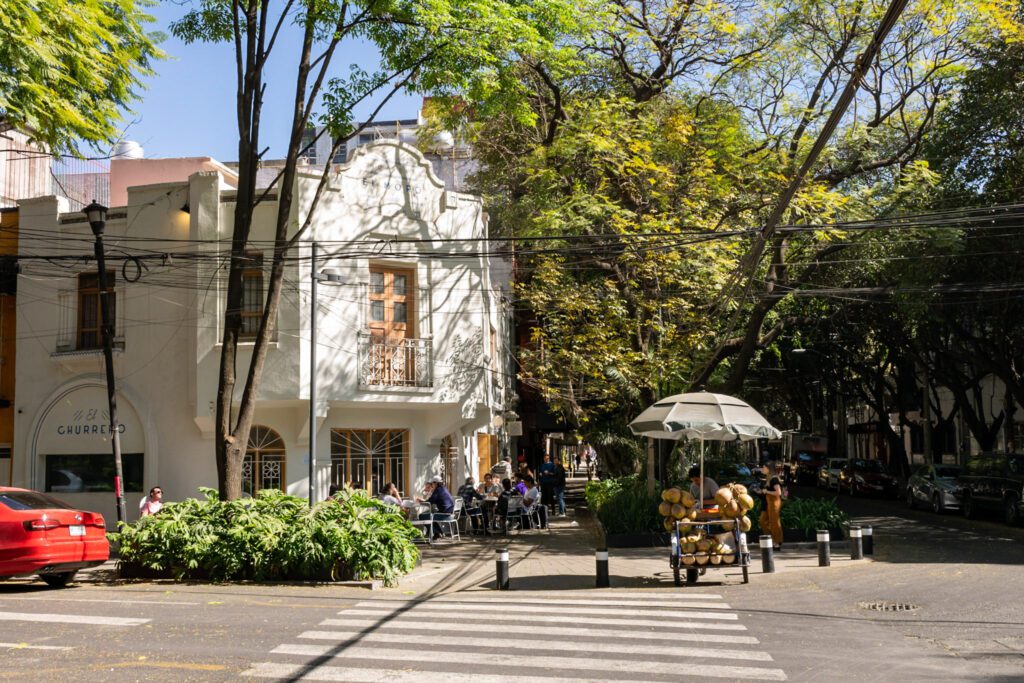
The neighborhood is sometimes referred to as “Condesa-Hipódromo,” and looking at a map tells you everything you need to know about why that name fits (particularly the second piece): it’s shaped like an oval, which is similar to horse racing tracks (which was actually used for horse racing until relatively recently in the early 20th Century).
Today, La Condesa is one of the most upscale neighborhoods in Mexico City (we learned that the name “Condesa” means “countess,” which tells you everything you need to know), and has become particularly popular with expats and tourists over the past decade or so. Including us.
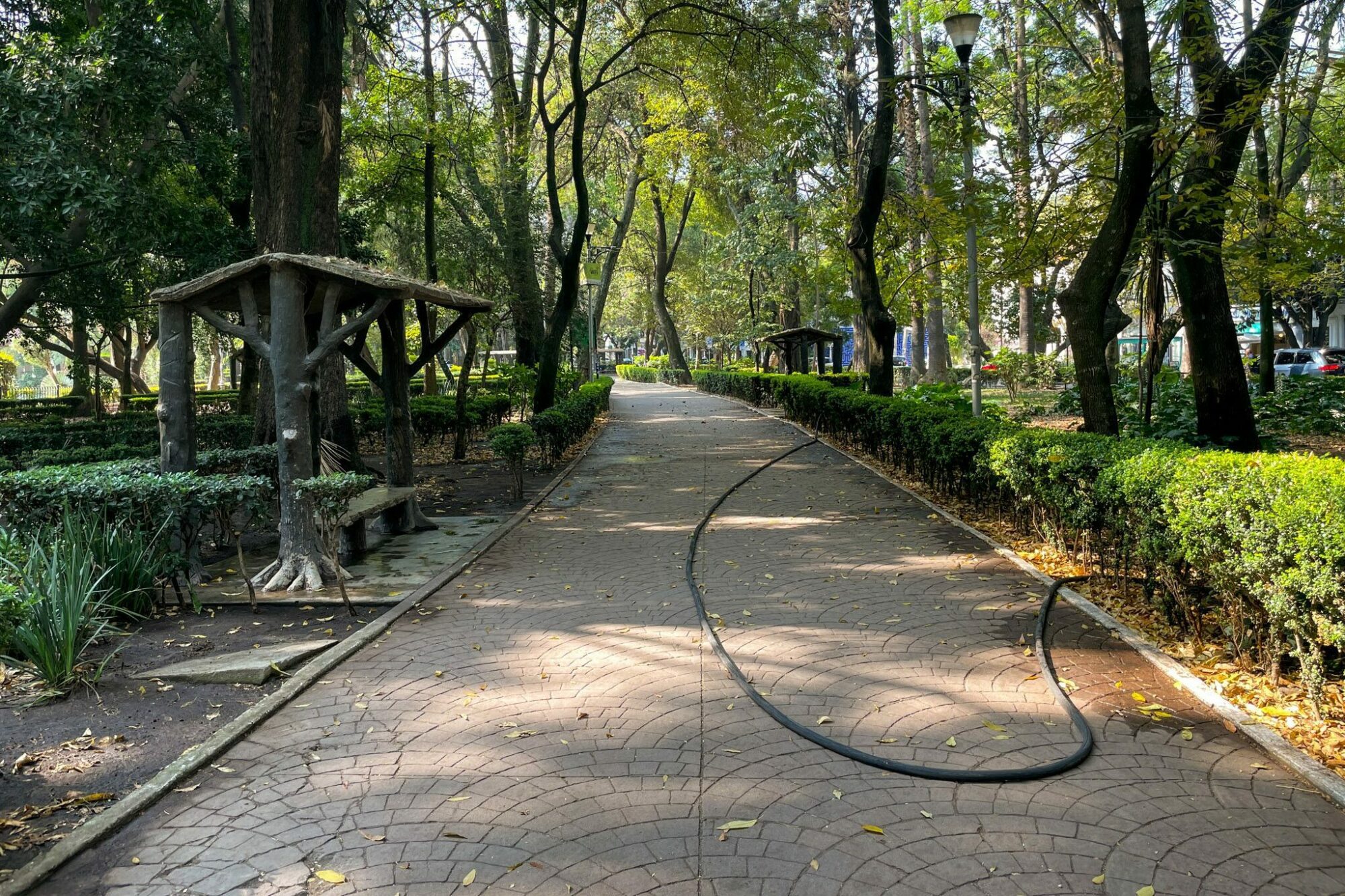
Here are our favorite spots in La Condesa, in no particular order (excluding the two parks, which you should absolutely visit).
- Churrería El Moro: Touristy? Yes. Lots of English is spoken here. Worth it? Also yes. You’ve no doubt heard about the churros con chocolate as you’ve been planning your trip, and this particular location is our favorite place to get them. It’s busy, yes, but you can grab your churros and chocolate and head across the street to the park to enjoy them in the big open space in front of the theater. On the trip with my brothers, I sent them in on their own to order, and they came out without chocolate for some silly reason (though they did come out with what was essentially a churro ice cream sandwich, which they loved). You want the churros and the chocolate español, which is the thicker version perfect for dipping churros. Yes, it’s a huge cup of chocolate, which is different from the version you might find in Spain.
- Baltra Bar: Our favorite cocktail bar in Mexico City! We’ve been here on every single trip, and seen it get more and more popular over that period of time. When we came the first time, we were one of two couples in the bar, and had a lovely chat with the bartender about Mexico City. On our latest visit, we had to wait for a table at the parklet outside because it was packed wall to wall. The cocktails are magical, and all of the syrups and cordials are housemade.
- Pasillo de Humo: Great Oaxacan spot with tlayudas, moles, and of course, mezcal.
- Tacos Hola: The compact taco spot where we discovered the magic that is tacos de guisado, which we now seek out when we’re traveling (Guisados in L.A. and Taquería Los Puñales at home in Portland are our favorites). Unlike tacos al pastor, tacos de guisados are filled with stews, usually meat-based. Walk into Tacos Hola and you’ll see a counter full of different colored clay pots, with a huge sign on the wall explaining what is in them. Highly recommend, though it’s more of a lunch spot (so you’ll have to come back at a different time).
- Maizajo: I originally walked by this spot, which is full of tortilla-making equipment, before doubling back because I was so intrigued (and on the lookout for fresh tortillas to cook breakfast with at home). The blue corn tortillas I bought here were among our favorites we had in Mexico City, and blew the supermarket tortillas out of the water. They also serve ready-to-eat food, though I just had the tortillas.
- Anvil and Camino a Comala: Mentioned above when we covered coffee in La Condesa before Bosque de Chapultepec, these are our two top coffee spots in the neighborhood.
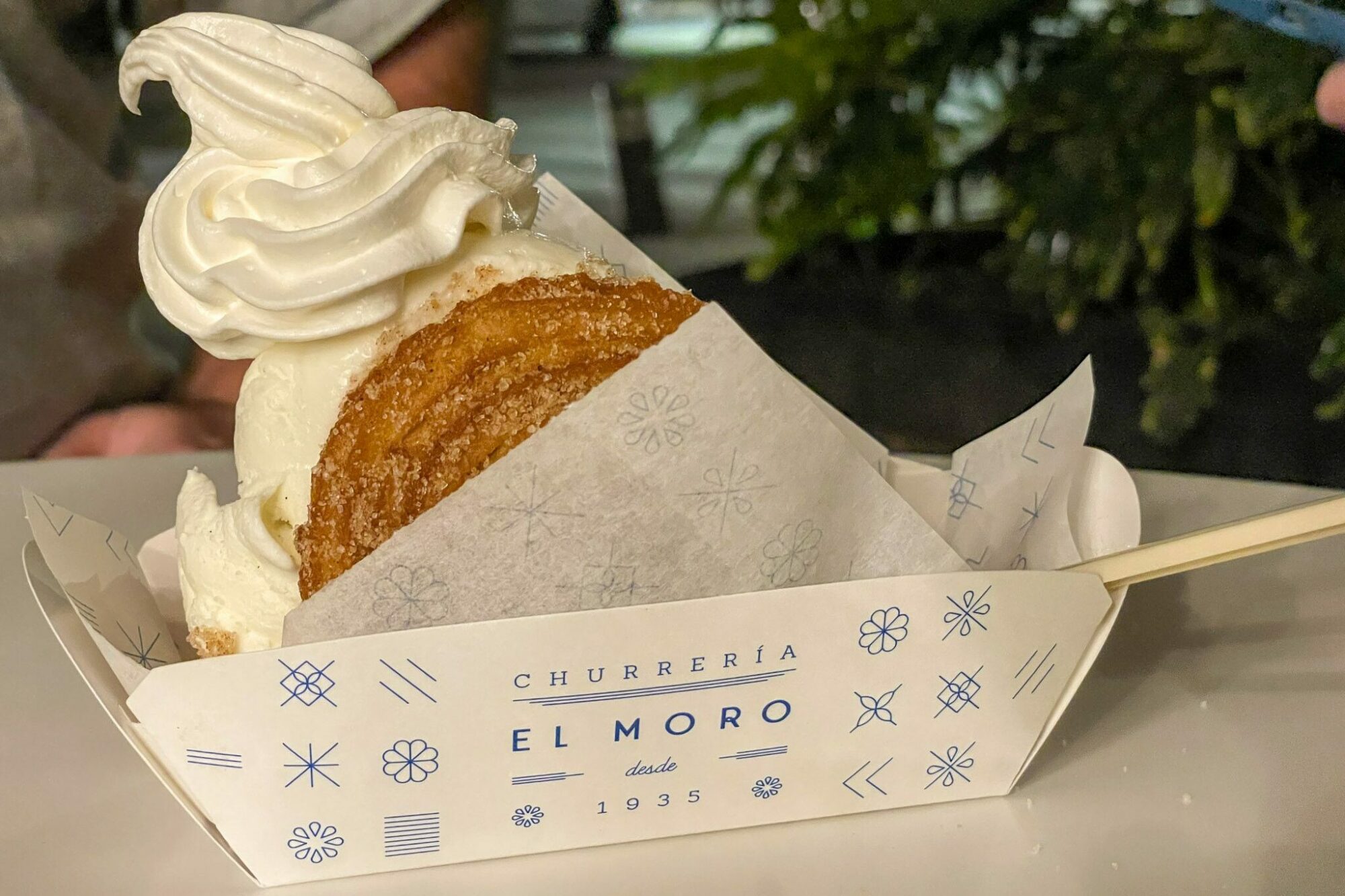
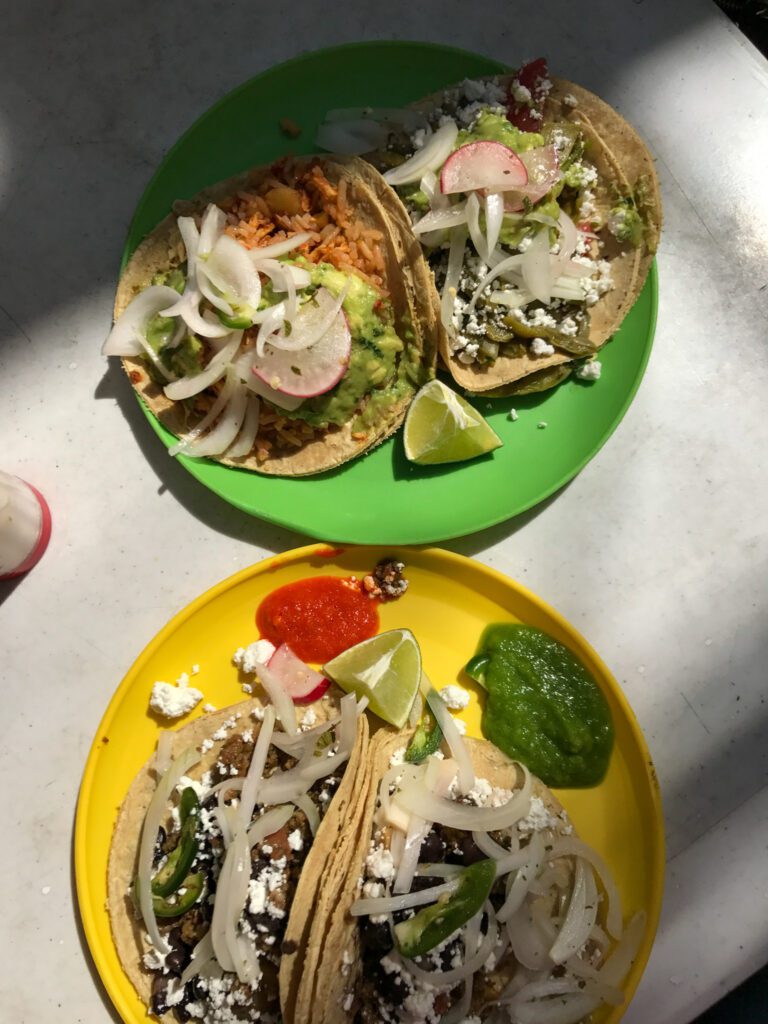
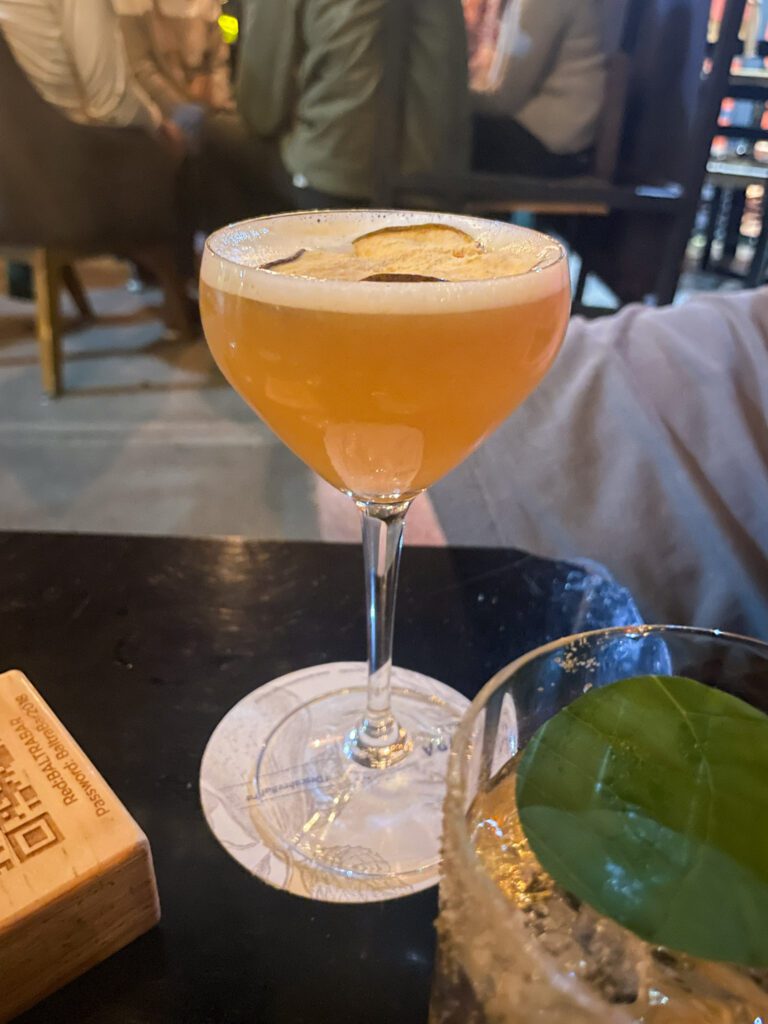
Day 4: Coyoacán and Xochimilco
On your last full day in Mexico City, spend the day south of the city center exploring two historic pieces of Mexico City: the canals of Xochimilco and the former village where the Spanish first settled near Mexico City.
Exploring Mexico City’s Complex History in Xochimilco
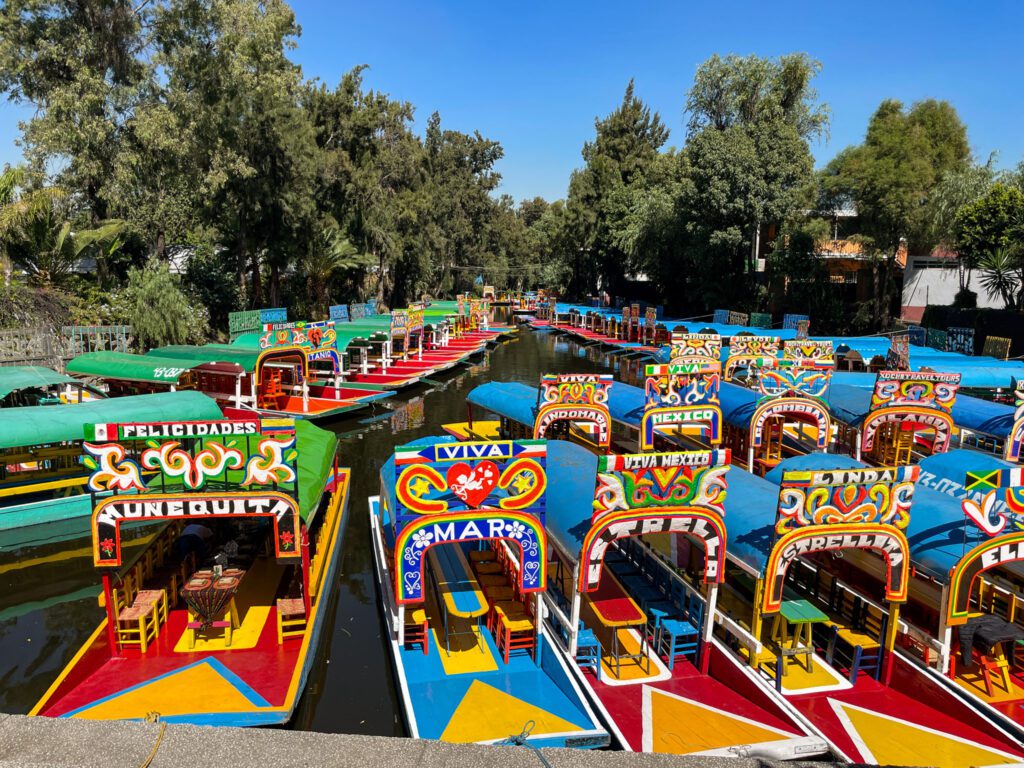
I’ll be honest (Matt here), I was VERY skeptical of Xochimilco. So much so that, despite two previous trips (including a weeklong stay) to Mexico City, I had never even seriously considered it as something to do.
All I could find were party boats that offered unlimited tequila and music for a couple of hours, which isn’t really our vibe.
However, after doing a tour (this one with Miroslava), I can confidently say that it is worth the time (and the journey, because it’s pretty far south of the city center) to get a sense for what Mexico City was like centuries ago when the Mexicas people – who we now know as the Aztecs – founded it.
If you didn’t already know (you should because I already mentioned it), Mexico City was essentially built on top of a massive lake.
The Mexicas people migrated from somewhere in northern Mexico or the southern United States, and decided that a big lake in the middle of a valley between some volcanoes was the PERFECT place to settle down.
For most of its history, Mexico City more closely resembled Venice than the huge, modern metropolis today.
The Mexicas created Chinampas, which are basically man made islands in the middle of the lake, using fertile soil so that they could grow food on them.
At one point near the time when the first Europeans showed up, there were three causeways (bridges) that connected the land in the center of the lake to the surrounding valley and beyond.
They even raised the bridges at night for security purposes.
There are some great maps of what that looked like at the Anthropology Museum, and I wish I had taken a picture of them to share because it’s a pretty wild transformation.
Those canals, which were spring fed and were the beating heart of Tenochtitlan (the Aztec city that stood where Mexico City is today), only really exist in one place today: Xochimilco. It’s a residential neighborhood about 30-45 minutes (depending on traffic) south of the center of the city.
The best way to experience them, I think, is with a tour where you can get the historical and cultural context that make this place a special slice of Mexico City.
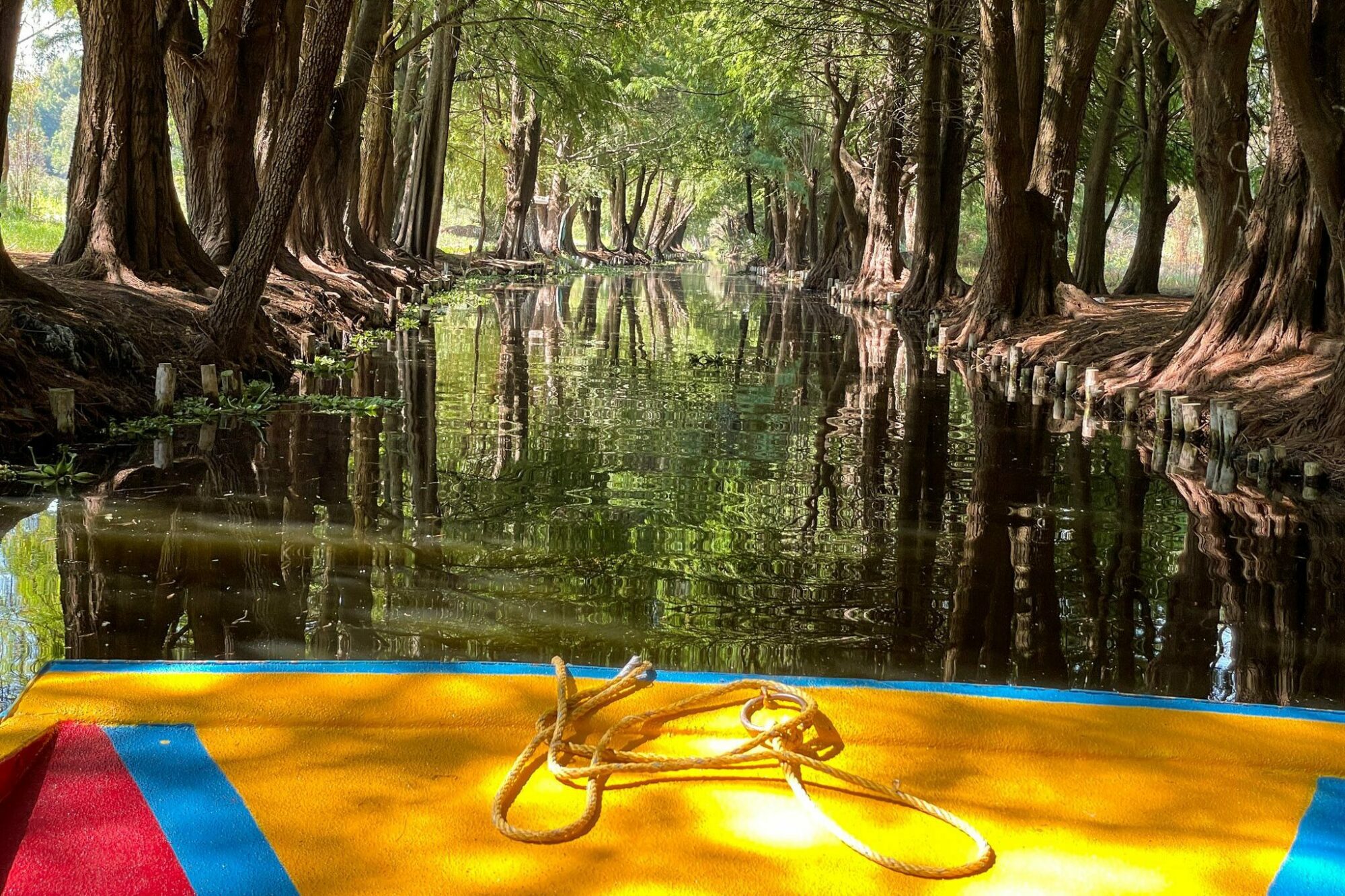
Unfortunately, most of the tours lean into the tequila side and are going to be light on the history and culture.
I did A LOT of digging to find this tour with Miroslava, a local who was born and raised in Xochimilco, who will show you her neighborhood
Her tour, which is equal parts market tour, cooking class, and history/culture lesson, takes a three hour journey through the neighborhood and canals.
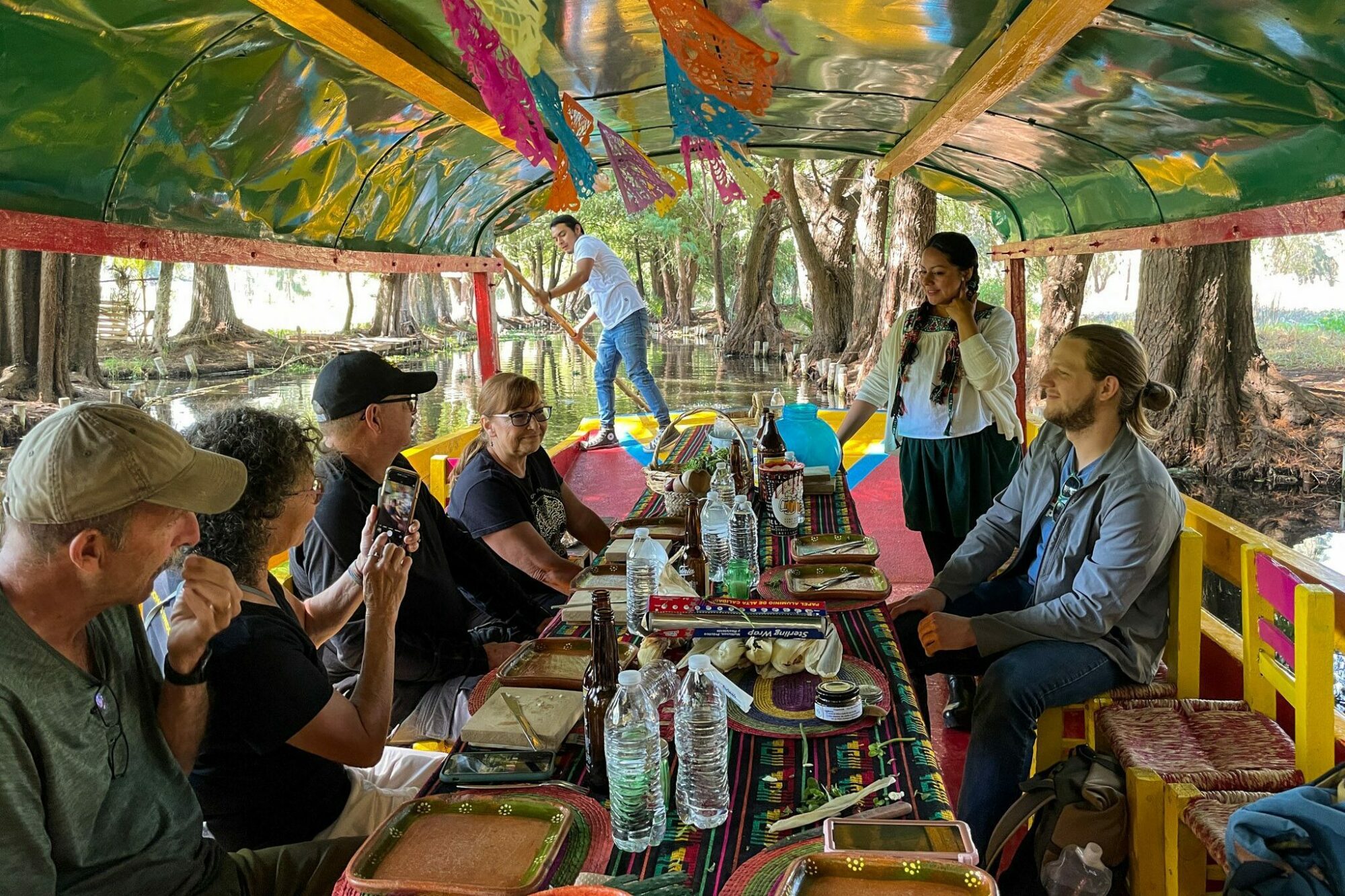
You’ll start in the neighborhood, stopping by the market to pick up veggies and cheese for your lunch (which is cooked on the trajinera), then head to the pier and onto the boat to learn about chinampas and the rare Axolotl (an adorable salamander that is largely extinct today).
Most tours don’t include transportation to or from Xochimilco (which will require either an Uber or long metro ride to reach on your own), but Miroslava’s tour includes a pickup in La Condesa to whisk you away, which we found valuable (if not a little cramped in the van).
Since it’s fairly south, it makes the most sense to combine Xochimilco with Coyoacán, which is between Xochimilco and the city center.
Exploring Coyoacán and the Frida Kahlo Museum (Casa Azul)
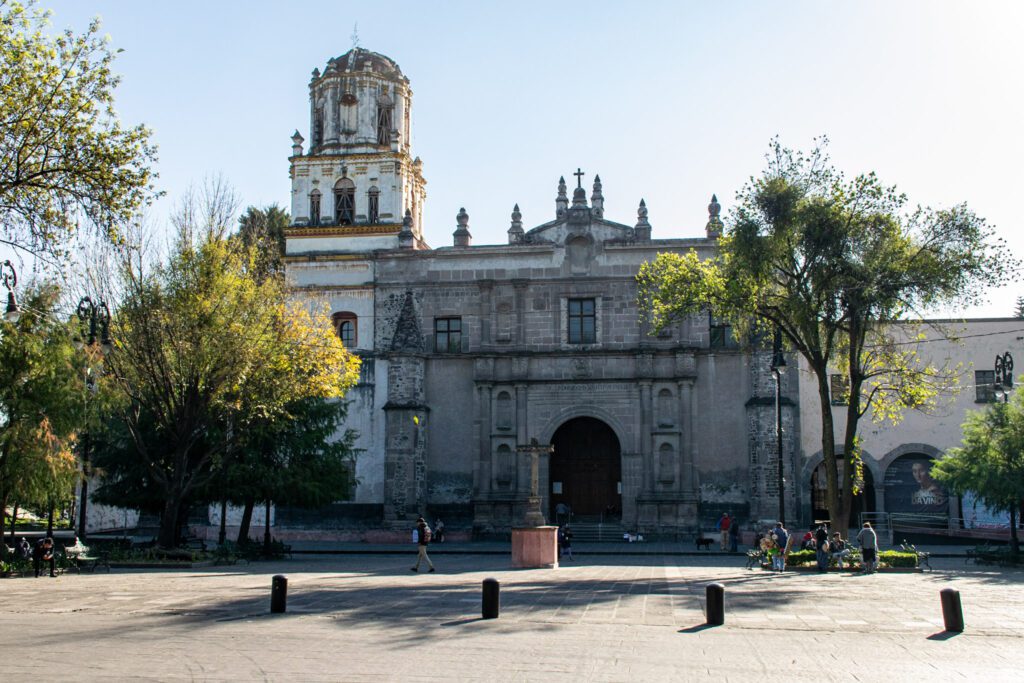
Coyoacán is a special place. Each time I walk through the main plaza in Coyoacán – the one with the beautiful coyote fountain – I can feel the energy pulsing around me.
I distinctly remember my first visit to that very spot and the question it brought forth: why don’t we have common spaces like this, where people gather and hang out together, in the United States? It’s the same feeling I have about the Italian piazza.
To us, the centerpiece of Coyoacán is Jardin Hidalgo and the aforementioned Fuente de los Coyotes because it is emblematic of the village-like feeling of the neighborhood.
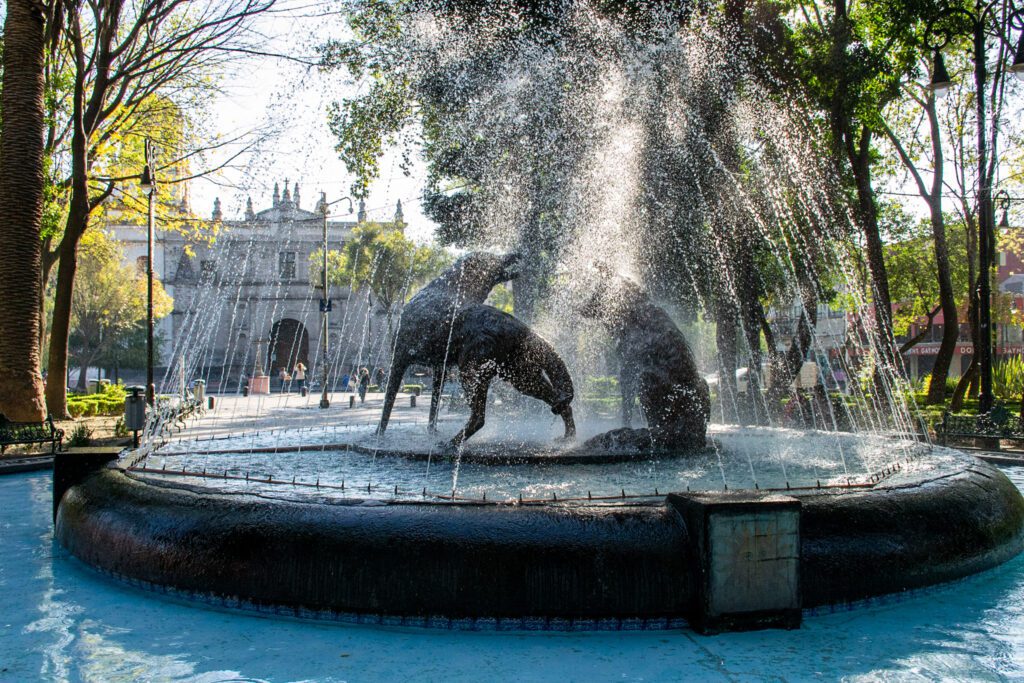
It’s very much a part of Mexico City, but when you step onto the cobblestone streets of Coyoacán, the density of Mexico City melts away, and while there are busy people streaming through the streets, it feels like a small slice of sanity in a hectic city.
The most famous attraction in Coyoacán is the Casa Azul, also known as the Frida Kahlo Museum.
It explores the life of both Frida Kahlo and, to an extent, Diego Rivera, the OG artist power couple and two of Mexico’s most famous historical figures.
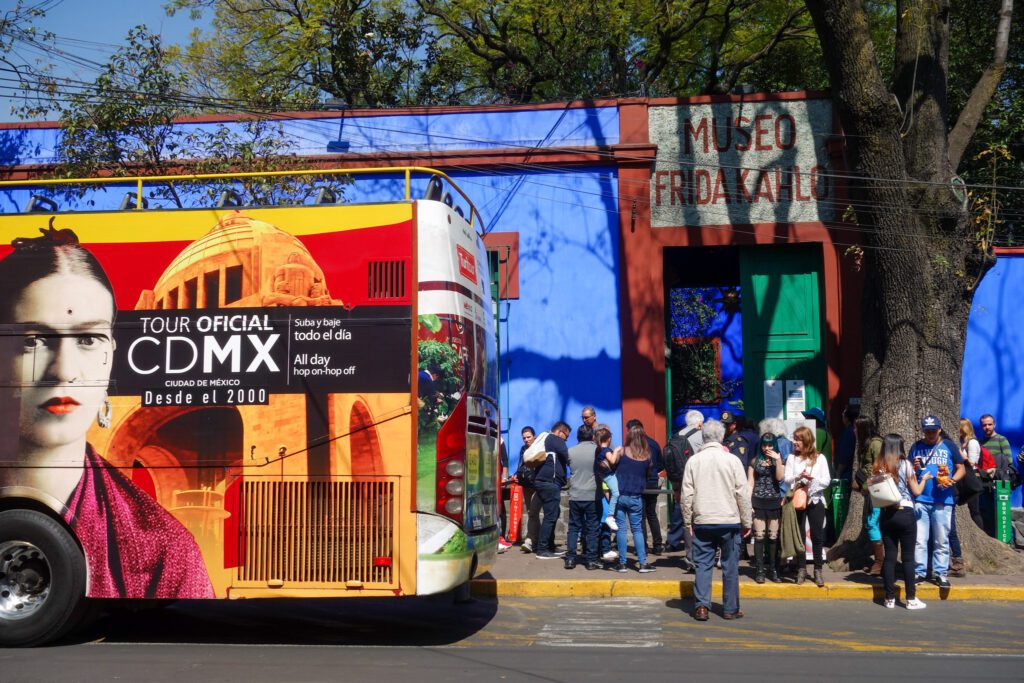
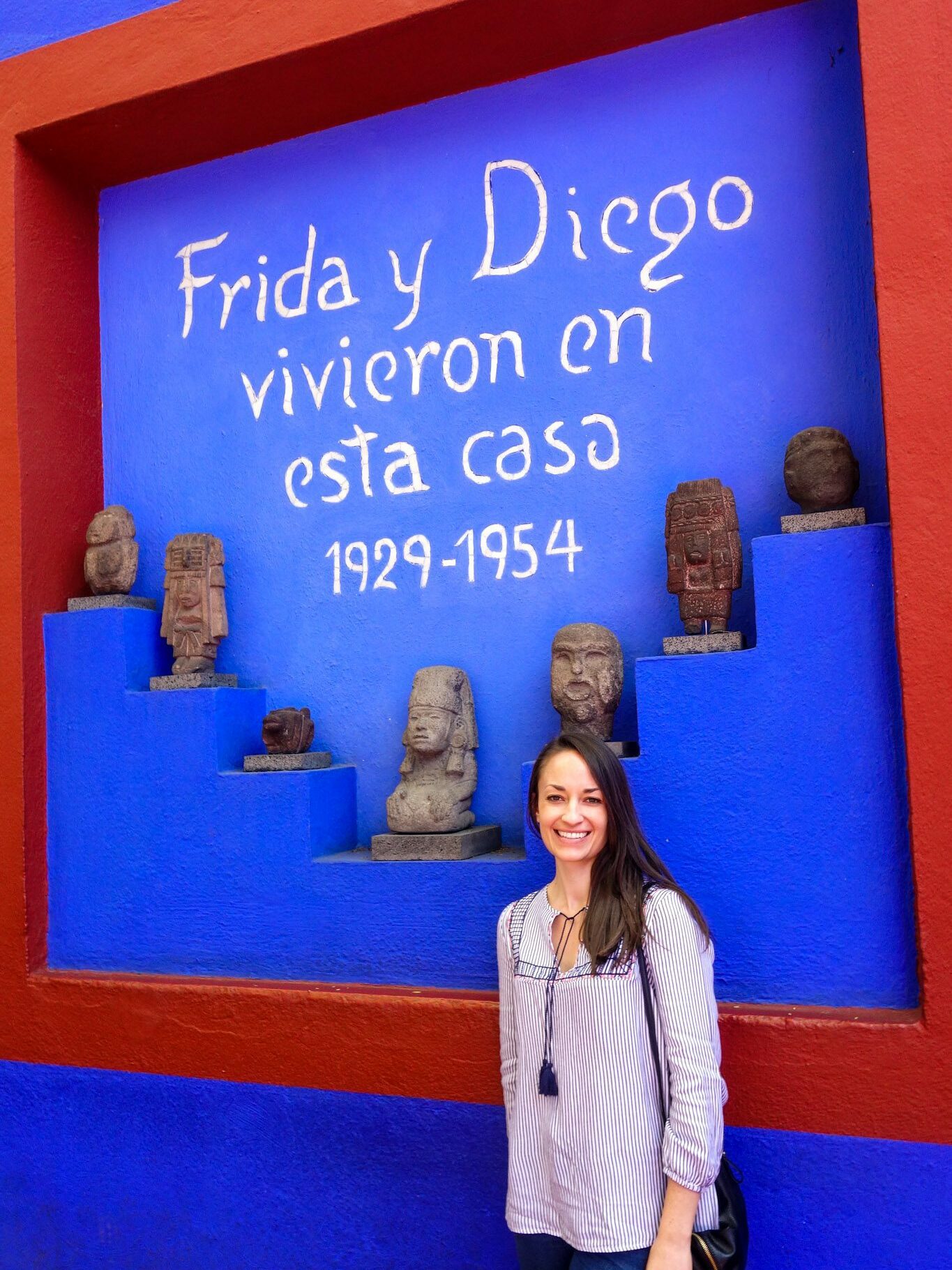
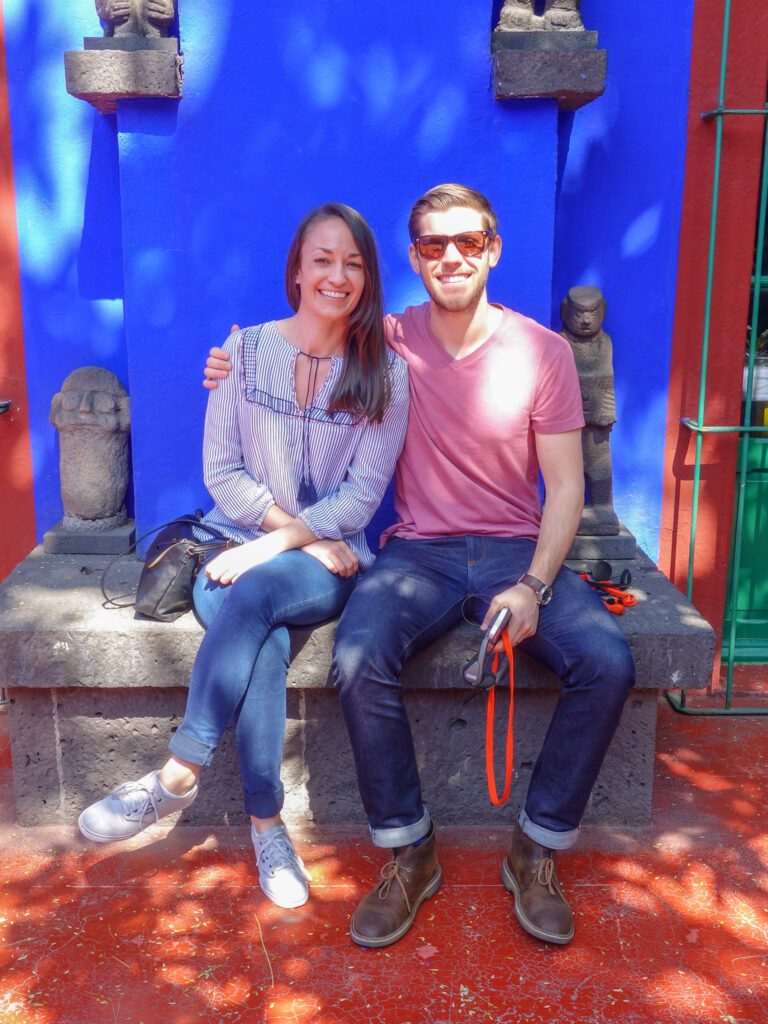
We did it on our first trip to Mexico City and it’s worth the visit, but only if you get the audio guide, which adds a lot of important context that make it a much more interesting experience.
One thing to know: this is one of the most popular (the most popular?) attractions in Mexico City, and it’s a compact space. We strongly recommend that you book tickets in advance, choosing a day and time. You can do that here.
Note that the museum is closed on Mondays.
Since you’ll be booking your Xochimilco tour in advance anyway, this shouldn’t be too much of a hassle if you’re doing them on the same day.
However, that is absolutely not the only thing to do or see in the neighborhood. Here are a few other spots to check out while you’re there.
- The twin plazas: Arguably our favorite piece of this neighborhood, the two plazas – Jardín Hidalgo and Jardín Centenario (and the beautiful Fuente de los Coyotes) – are the centerpiece and beating heart of Coyoacán. The energy here, at basically any hour, is palpable.
- Cafe Avellaneda: An absolute must-stop for coffee lovers, this tiny cafe on a cobblestone side street serves up my favorite Mexican coffee roaster, Jiribilla (they share the same owners). They have filter coffee, espresso drinks, and a great menu of specialty drinks, including an excellent espresso tonic.
- Mercado de Coyoacán: A great example of a market in Mexico City, and one that is slightly less hectic than some of the markets in the historic center. It’s part produce and other food stalls, part crafts, and part restaurants. The tostada stands, in particular, are worth a stop (there are many these days, and you want the big one with yellow walls and orange lettering).
- Centro Cultural Elena Garro: Part bookstore, part community center. This space is worth stopping by for the architecture alone.
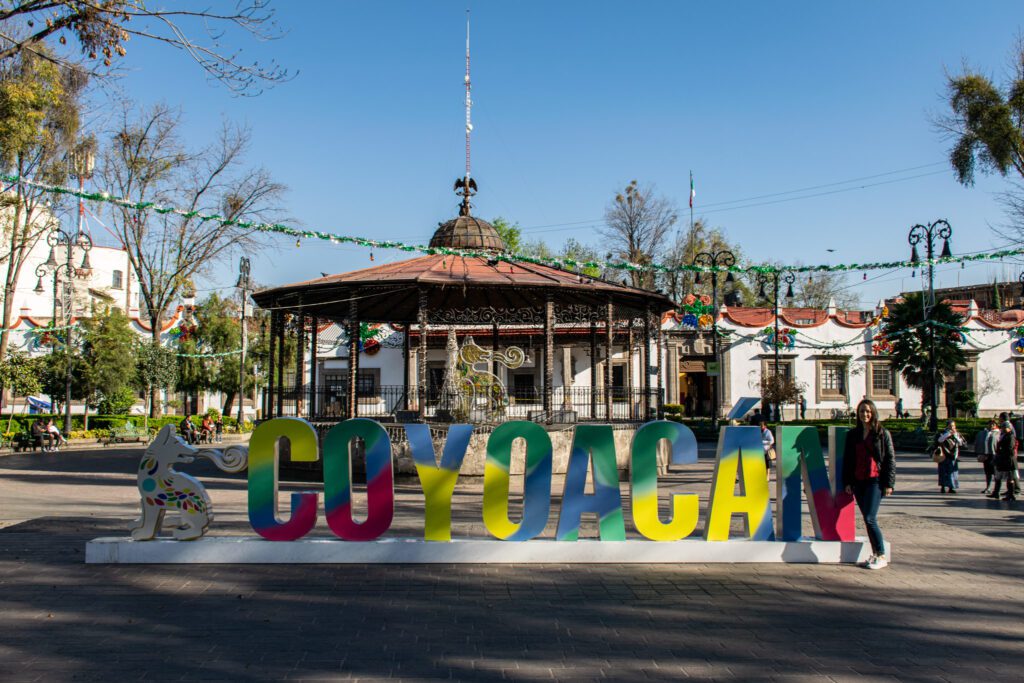
What to Do with More Time in Mexico City
Here are a few things we’d add to your itinerary if you have more time.
Teotihuacan
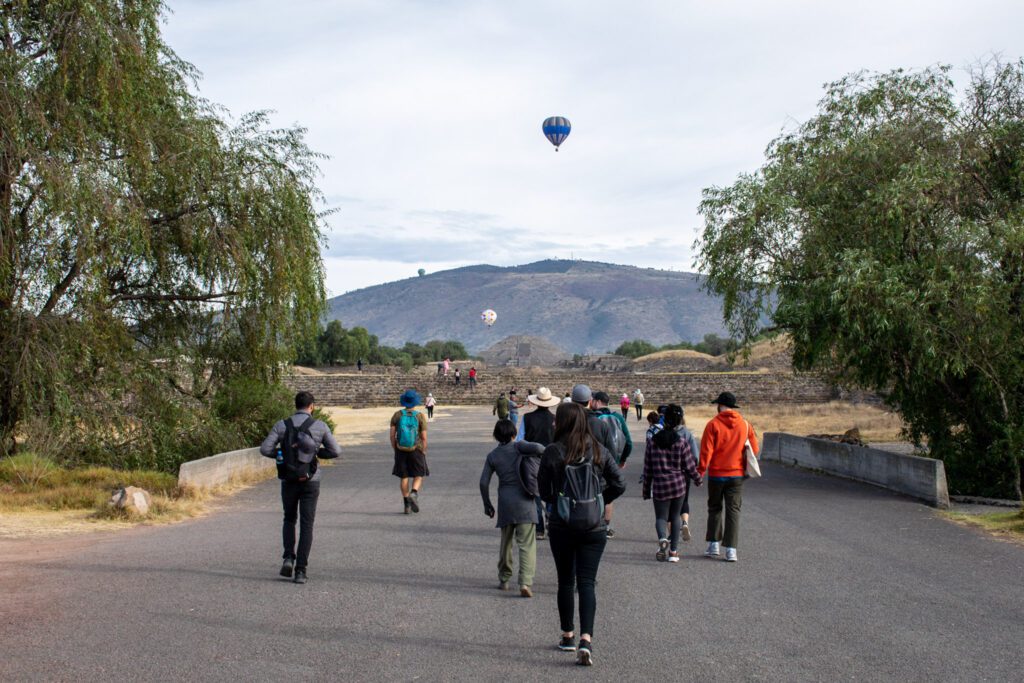
You’ll have no doubt heard about the massive pyramids of Teotihuacan multiple times over the course of your time in Mexico City,
Much like the Colosseum or just about any other very old set of ruins, we think the best way to do it is on a guided tour. Especially considering the transportation situation in this case – most tours include a ride out to the archaeological site, which is roughly 45 minutes outside of the city.
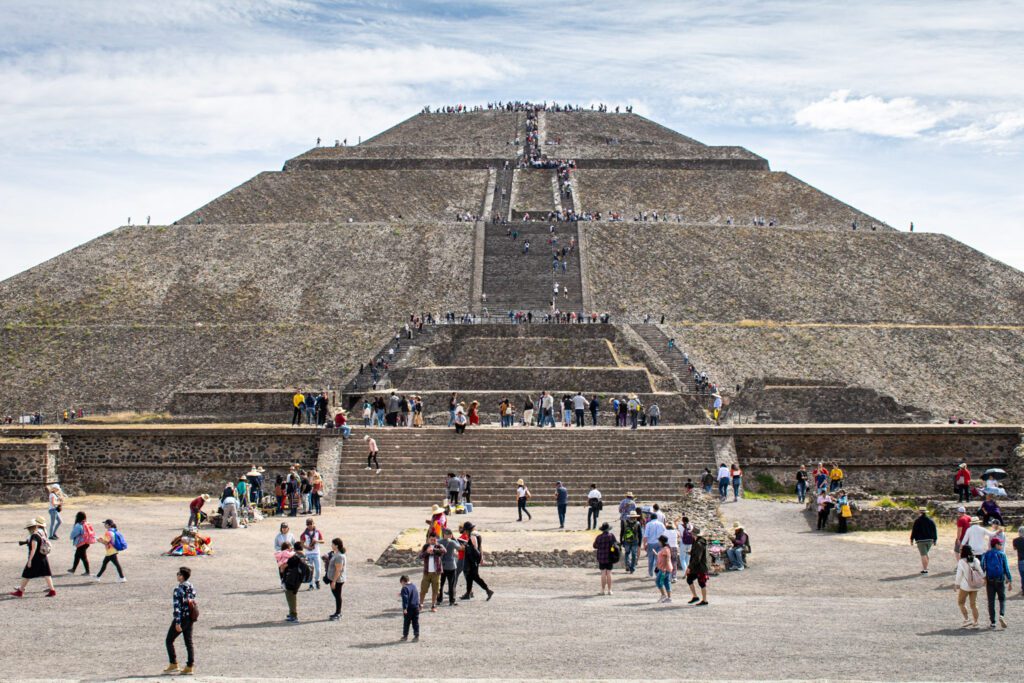
A guided tour with someone who knows what they’re talking about will make the experience significantly more rich and detailed.
We did this tour, which includes transportation and a tour of Teotihuacan, lunch at a house nearby, and a special addition at the end.
We enjoyed it, but we think it dragged on longer than it should have (particularly the pieces at the end after leaving Teotihuacan) and we’d probably recommend a different tour if you’re relatively short on time. It truly is a full day extravaganza.
A few tips for you here. The site is VERY exposed, with limited opportunity for shade. Bring a hat, wear long sleeves, and wear sunscreen.
Take a Street Food Tour
Another thing that didn’t quite make the cut in the main itinerary above is a street food tour (we chose the cooking class instead, because it was the experience we preferred).
A street food tour is a great way to experience one of our favorite things about Mexico City; the vibrant culture of stands and stalls of all shapes and sizes that line the streets.
In fact, when we talk about the best things we’ve eaten in Mexico City over multiple trips, the answer usually includes multiple street food items. But especially blue corn quesadillas with squash blossoms, and tamales dulces (the pink ones).
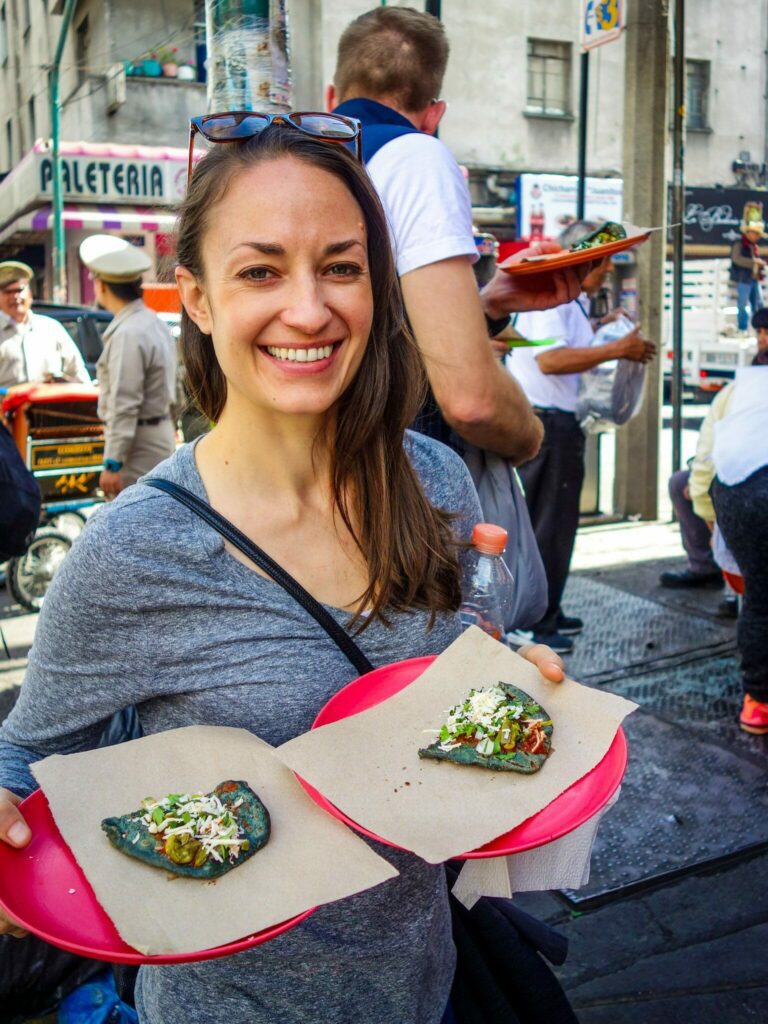
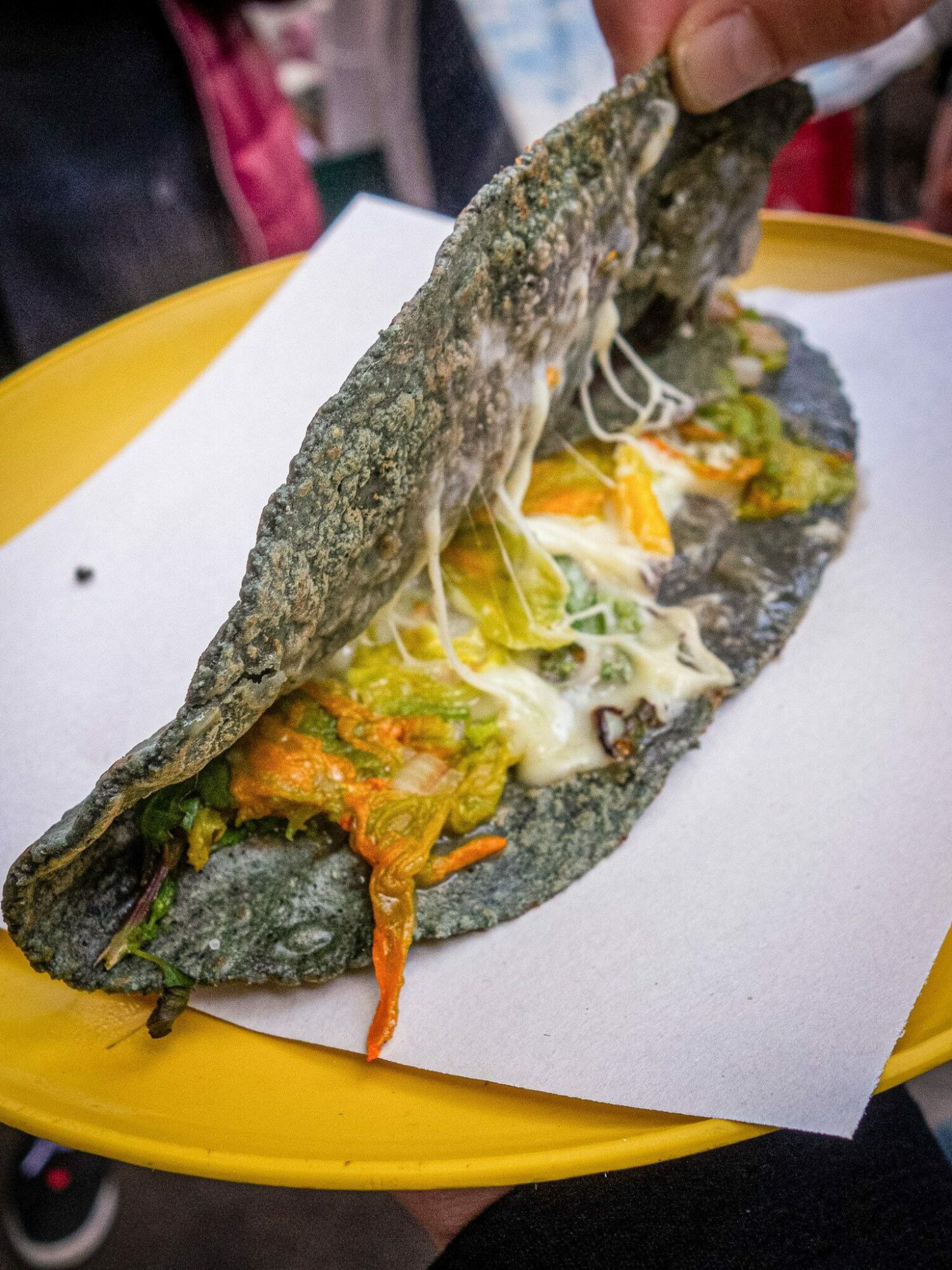
But the question of what you should eat and where you should eat it is going to loom large.
If you haven’t already noticed, we’re big proponents of hiring locals to help you dive deep into a topic because it almost always leads to a richer, deeper understanding and appreciation for whatever it is you’re exploring.
It’s one of the most important lessons we’ve learned on countless trips over the past few years, and we’d implore you to learn that lesson sooner than we did on our travel journey!
In this case, you’ll come away from a guided tour with more understanding of Mexican food culture (and culture more broadly) after spending 3-4 hours wandering and eating with a local guide and your fellow curious travelers.
We know because… we’ve done it.
We have two recommendations for you on this front. There are thousands of street food tours in Mexico City at this point, and we think it’s important to choose a company that is both local and does the right things in terms of their relationships with the various vendors you’ll visit.
We’re going to give you one company that we have personally done a tour with, and one that we’ve wanted to do for years, but haven’t quite made happen just yet.
In terms of the tour we’ve done, that would be Club Tengo Hambre’s Street Food Essentials Tour, which basically does a big loop starting at Palacio Bellas Artes and goes on a food-filled journey (we had 7-8 different foods) that lasts several hours and leaves you full for days.
They also have a few other tours, including a Condesa food tour and a tour of Merced Market.
In terms of a tour we haven’t done ourselves but have wanted to, we’d point you towards Eat Like a Local. If we were going to start a tour company, this is the model we’d follow.
Paying your people and vendors a living wage. Supporting small, local businesses. And taking travelers on a journey where they’ll discover things they would never have found without your local knowledge.
You can read more about them and their founder here.
They have a couple of different tours, but their flagship Mexican Food 101 tour is the one we’d recommend if it’s your first time in Mexico City. It includes a market tour, a flower market, and, of course, all sorts of foods along the way.
A third option would be this street food + bike tour, which allows you to cover A LOT more ground than if you were walking, which is helpful in a city as big as Mexico City.
What to Do with Less Time in Mexico City
If you have less time in Mexico City – two or three days – here’s how we would alter the itinerary above to fit that time.
For the most part, you can use the information in the main itinerary for the finer details on the things you want to do.
With Three Days
With three days, we’d make a few changes to the itinerary above. The biggest change is to cut Xochimilco, mostly because it’s really far from everything else, and we think you’re better off spending that time elsewhere.
For your other three days, similar to above, you’re going to anchor your days around a main experience each day: the walking tour, the cooking class, and the Anthropology Museum.
The biggest thing to figure out is where a trip down to Coyoacán, which we think is a MUST DO, fits on this version of the itinerary.
Our recommendation is to do it on the morning of the Anthropology Museum tour, which means you’re probably going to want to skip the National History Museum.
That’s going to make it a little bit of a long day, but we can’t find a better way to organize it (believe us, we tried).
With those two changes, you can essentially follow the bulk of the itinerary as written.
With Two Days
If we’re being completely honest, two days in Mexico City is just not enough time to do the massive city justice.
However, if two days is what you’ve got, here’s how we’d make the most of it.
On your first day, follow day one of the itinerary above as written.
Of all the experiences in the main itinerary, we think the walking tour is the most important because it really gave us a foundation of knowledge about the city, the people, and its history, that made the rest of our time a richer experience.
On your second day, spend the morning down in Coyoacán, get coffee at Cafe Avellaneda, stop by the two plazas and the coyote fountain, and then head over to Casa Azul (Frida Kahlo’s House) to check it out.
For the second half of the day, spend time exploring Roma Norte and La Condesa. Get pastries at Panaderia Rosetta, coffee at Cardinal, lunch at Expendio de Maíz, and hang out around the parks in La Condesa. Cocktails at Baltra are also a must-do, along with churros at El Moro.
It’s a quick two days, but the pace is worth it, we think.

Hi Matt, I am gluten insensitive and love pastries and would love love love to eat a churro. Are you saying that Churros at el Moro in Condessa are wheat free? Are there wheat free Pastries at Panaderia Roseta ?
We are heading to CDMX in 2 weeks and appreciate your website! Muchas Gracias!
Hey Lauren! No, I am definitely NOT saying that. The churros at El Moro are NOT gluten free. I dragged my brothers there to try them, but I did not eat them myself. Note that in these itineraries, not everything I mention is gluten free (Alysha is our designated gluten-eater when we need to try things for science). I write separate gluten free guides for Celiacs which have far, far more detail!
Hi there! Were you able to eat anything at Churrería El Moro gluten free?
Hey Miranda! Nope, I dragged my brothers there to try it, but did not eat anything there myself. There are no gluten free options on the menu, and even if there were, I would doubt their safety for Celiacs or people sensitive to gluten given the environment.